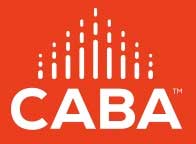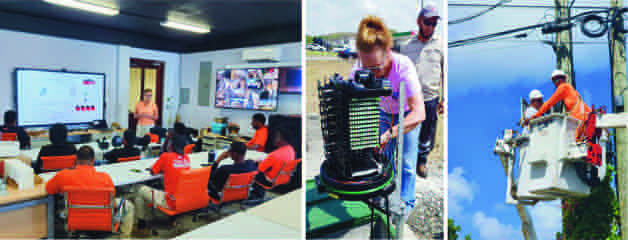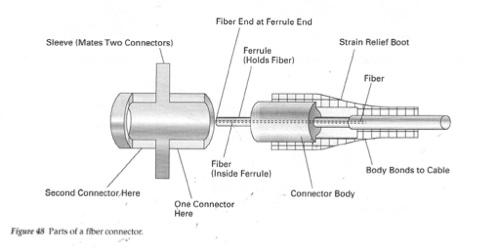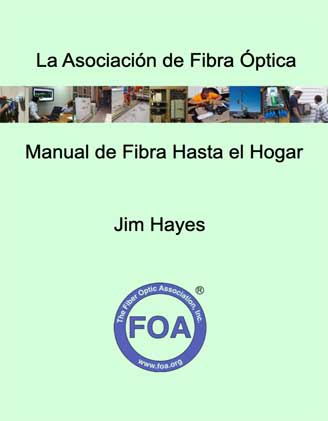] 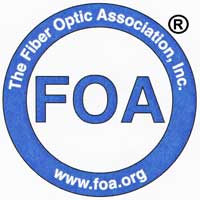
 June 2023 |
|||||||||||||||||||||||||||||||
Search the FOA website FOA Home Page Contact Us |
Sign up for the FOA eMail Newsletter Privacy Policy Sections
|
||||||||||||||||||||||||||||||
FeaturesFOA And Workforce DevelopmentClearfield And Workforce Development Get The Facts Right Disruption? Approaches To Broadband The Cost Of Middle Mile Construction New Fiber U MiniCourse on Jargon New FOA Schools Around The World FOA Schools Map Links To Resources On Broadband Newsletter SectionsClick on any link to jump to that sectionNews Supply Chain Problems Disappear Launch of ViaSat-3 - The "Terabit Satellite" Hiring And Training At Charter In Missouri Hoisting Grip May Have Caused Fatality Next in FTTH - Mergers & Acquisitions Nuclear Power For Data Centers? ISE Expo 2023 Global Excavation Safety Conference 2024 FiberWizards Online Programs Technical Converting CATV HFC To PON Coherent PON Spec Released Problems With High Fiber Count Cables? Confusing Jargon - Colored or Gray Fibers Links For High Level Engineers Managing Projects - Gantt Charts FOA Color Code Guides FOA Online Loss Budget Calculator Worth Reading Lots of interesting articles Q&A Questions from our readers Always Interesting! Training/FiberU New FOA-Approved Schools, Fiber U MiniCourses more Resources New FOA Technical Resources Safety About the FOA FOA Certified Techs: 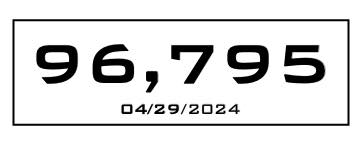 Special offer - 1/3 Off Renewal Jobs
Where Are The Jobs In Fiber Optics? FOA talks about all the applications for fiber optics, what jobs involve and the qualifications for the workers in the field in this YouTube video. Want to be notified when the FOA Newsletter is updated? Sign up for the FOA eMail Newsletter. You can also sign up from your cell phone: text "FOA" to 22828 (usual text message charges apply) Trademarks: The FOA CFOT® (Certified Fiber Optic Technician) and Fiber U® (the FOA online learning site) are registered trademarks of the FOA.  Want to know more about fiber optics? Looking for specific information? Here's the largest technical reference on the web: The FOA Online Fiber Optic Reference Guide. 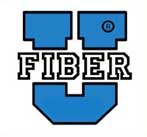 Free online self-study programs on many fiber optics and cabling topics are available at Fiber U, FOA's online web-based training website. FOA Reference Books Available Printed or eBooks The fiber book is available in Spanish and French 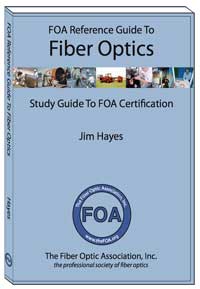 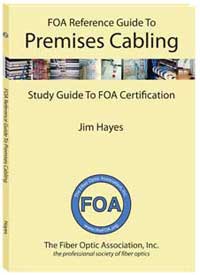 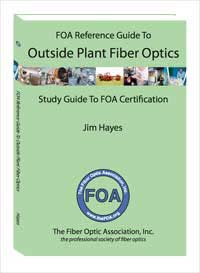
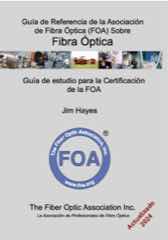 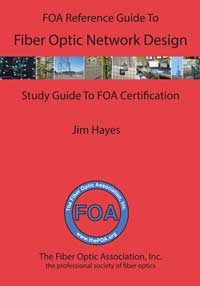 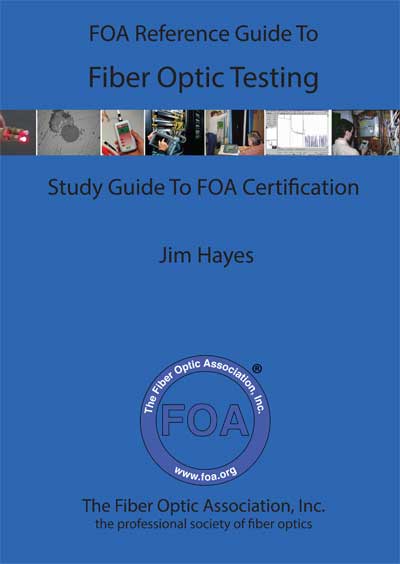
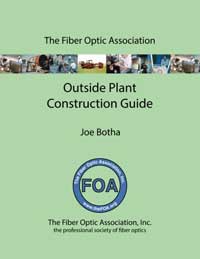 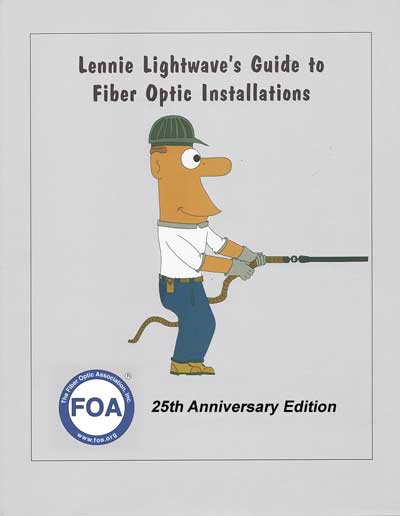 Lennie and Uncle Ted's Guides are now also available as free iBooks on iTunes. 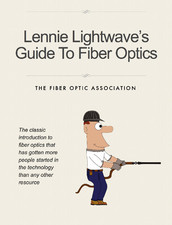
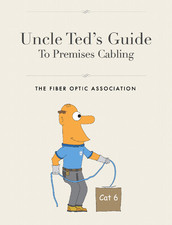 Click on any of the books to learn more.
FOA Videos on FOA is a member of: The FOA Newsletter is edited by Jim Hayes - send your stories, leads, ideas, comments to <jim @ foa.org>  Search the FOA Website With DuckDuckGo Top Stories From The Past FOA Newsletters
1/22, 2/22, 3/22, 4/22, 5/22, 6/22, 7/22, 8/22, 9/22, 10/22, 11/22, 12/22 1/13, 2/13, 3/13, 4/13, 5/13, 6/13, 7/13, 8/13, 9/13, 10/13, 11/13, 12/13 1/12 , 2/12, 3/12, 4/12, 6/12, 7/12, 8/12, 9/12, 10/12, 11/12, 12/12 1/11 , 2/11, 3/11, 4/11, 6/11, 7/11, 8/11, 9/11, 10/11, 11/11, 12/11, 1/10 , 2/10, 3/10, 4/10, 05/10, 07/10, 08/10, 09/10, 10/10, 11/10 1/09 , 2/09, 3/09, 04/09, 05/09, 07/09, 08/09, 09/09, 10/09, 11/09, 12/09 1/08 , 2/08, 3/08, 4/08, 5/08, 6/08, 7/08, 8/08, 09/08, 10/08, 11/08, 12/08 12/07 , 11/07, 10/07, 09/07, 08/07, 07/07, 06/07, 05/07, 04/07, 03/07, 2/07, 1/07 12/06 , 11/06, 10/06, 09/06, 8/06, 7/06, 6/06, 5/06, 4/06, 3/06, 2/06, 1/06, 12/05 ,11/05, 10/05, 09/05, 08/05, 07/05, 6/05, 5/05, 4/05, 2/05, 01/05, 12/04 , 10/04, 9/04, 8/04, 7/04, 6/04, 5/04, 4/04, 3/04, 1/04, 12/03 , 11/03 10/03 9/03, 8/03, 7/03, 6/03, 3/03, 10/02 , 8/02, 5/02 Current Issue of FOA Newsletter Highlights from the FOA Newsletter in 2022Multiple bullets hit Xfinity fiber cable, causing outage in Oakland (February 22)More Thoughts On Broadband For Rural Areas (March 22) (June 22) Fiber Optics In The Movies - Star Wars Special Effects (March 22) Fiber Optics Again Helps Find A Famous Shipwreck (April 22) Thinking About A Fiber Optic Project? Better Get Started Soon (April 22) AT&T Says Good-bye To Copper (April 22) More Pole Stories And Photos (May 22) Why Stop At Gigabits? Let's Design Fiber Networks For Terabits (July 22) Understanding The Fiber Optic Workforce (August 22) Does the Infrastructure Investment and Jobs Act (IIJA) truly benefit people in rural America? (September 22) Can Wireless Compete With Fiber? Satellites? (October 22) What is Certification/How Do you Learn (November 22) School Special Issue (with photos) (December 22) New Fiber U Self Study ProgramsFiber Characterization (for long distance, high speed networks)Minicourses: Attenuators, Reference Cables, Project Management December 2022 Special Feature: A Salute To FOA's Schools And Training Organizations |
Don't miss News and Technical this monthFOA Has Proven Results In Fiber Optic Workforce DevelopmentAt least a couple of times a week, we read another article about fiber optic workforce development, mostly asking where are the fiber optic technicians we need and saying more be recruited and trained (Fierce Telecom, CI&M). We also see groups lining up to offer training (much of which is newly created) because the billions of dollars being offered by the US funding programs for broadband include millions of dollars for training. What's missing from these articles are a understanding of the fiber optic workforce and proven solutions to training and certifying fiber techs.That's where the FOA stands apart. FOA was founded in 1995 to develop a workforce to build the Internet, telecom and premises networks, all of which were based on fiber optics. The founders were all professional trainers, many with more than ten years experience in the field as well as training fiber techs. They came from industry, government and education; two were college professors already teaching fiber at their schools. That unique mix of experienced fiber techs and trainers with educators led to the development of the FOA KSAs (knowledge, skills and abilities) and FOA recommended curriculum would have the content needed for training fiber techs coupled with the techniques to train then properly and test their competence for certification. FOA has never lost sight of our original charter "to promote professionalism in fiber optics through education, certification and standards," and FOA's role today is still to educate the techs working in fiber optic industry. When we read these articles about the fiber optic workforce needed for the future, we can point to proven ways to achieve those goals. Perhaps the best example is the Kentucky Wired project. When Kentucky decided to build their own backbone fiber optic network to connect all 95 counties, no service provider would work with them, a classic response to rural networks. So they went ahead on their own, funding the project themselves, Shortly after it started, they contacted FOA, wanting to know how many fiber techs were based in Kentucky. We searched FOA certification records and found exactly 2 CFOTs in Kentucky! But FOA knew how to build a workforce. We flew to Kentucky and brought together the state officials, the contractors they had hired and educators from the Kentucky Community and Technical College System (KCTCS). We had each group tell the others what they wanted to accomplish and what problems they saw achieving their goals. One of the KCTCS schools was already part of the FOA Approved School network so we had a model for training fiber techs which we introduced to 8 more KCTCS schools. 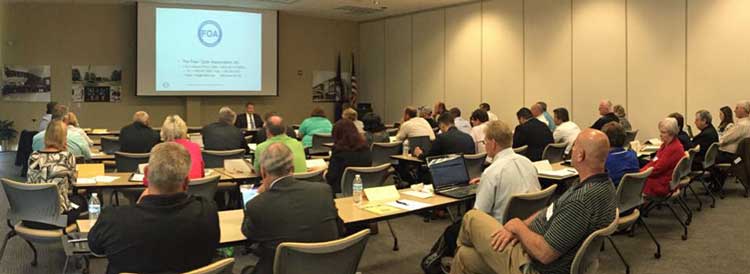 Kentucky Wired Workforce Summit - June 2016 Today, those 9 KCTCS schools have trained and certified 1200 fiber techs and working with the contractors they finished Kentucky Wired's backbone to all 95 counties last Fall. Those techs, a mix of young people seeking good careers and adults needing job training/retraining (even laid-off coal miners!) who completed CFOT courses at those 9 schools around the state, are ready to build out the rest of the network in the areas of the state where they reside. That is workforce development success. From 2 to 1200 CFOTs in less than 6 years and geographically diverse so they are now capable of building the rest of the network in areas where they live and are now needed to complete the job. FOA is now working with other states to implement similar programs. We're learning from them too. For training techs for building broadband networks, Ohio showed FOA how our Premises Cabling (CPCT) curriculum was just what they needed for one school which specialized in training customer premises installers. We're working with several others to expand the OSP curriculum to include construction (bucket trucks, backhoes and all) using facilities they already have for general construction. FOA also has programs ongoing with unions like IBEW (~35 local JATCs) and CWA, community and technical colleges (~65 in the US) as well as many profesional training organizations and companies like Clearfield (see below) - that is how the FOA has certified over 91,000 fiber optic techs who hold over 120,000 certifications. Manufacturers Like Clearfield Can Be Part Of The Workforce Development Solution
As we have mentioned many times, the founders of FOA
included companies that had been active at training themselves,
Siecor/Corning, 3M, AMP, Panduit, Fotec, ATC, etc. All started training
because fiber optics was a new technology, unfamiliar to techs, even
those currently working on telecom, CATV or computer networks and the
manufacturers were concerned that these techs would install their
products properly. | ||||||||||||||||||||||||||||||
| Region |
Location |
Contract Amount $millions |
Miles (km) |
Cost/Mile |
| 1 |
Northern CA (mostly rural) |
$778.5 |
1,860 (3,000) |
$418,000 |
| 2 |
Bay Area to Nevada (highly urban to rural) |
$421.6 |
1,300 (2,100) |
$324,000 |
| 3 |
Central Valley (rural, farming, small/medium towns) |
$247.9 |
950 (1,550) |
$261,000 |
| 4 |
Southern CA Los Angeles, Ventura Orange Counties (dense urban, suburban little rural) |
$352 |
800 (1,300) |
$440,000 |
| 5 |
So CA (more rural, farming, desert) |
$67.3 |
290 (470) |
$232,000 |
Not surprisingly, the flat rural Central Valley and Rural/desert areas come in the lowest, urban areas are higher, but the surprise is the Northern California area which is rural, but also rugged terrain, comes in high also.
You can read the California Dept. of Technology announcement here.
New Fiber U MiniCourse - Fiber Optic Jargon
There is a new MiniCourse at Fiber U - Fiber Optic Jargon. Jargon is the most important thing you need to learn when you learn about a new technology. This short Fiber U MiniCourse is intended to introduce you to fiber optic jargon and make learning about fiber much easier. It's aimed at novices but is a good refresher for even experienced techs.New Fiber U MiniCourse Fiber Optic Project Management
FOA Welcomes New Approved Training Organizations
FOA is pleased to welcome 4 new schools to the
worldwide network of training organizations offering FOA approved
training and FOA certifications. With FOA's extensive worldwide network
of training organizations, it's possible to get FOA-certified almost
anywhere! Use the updated FOA schools map below to find any FOA school.
413 tbaytel Thunder Bay, Ontario, Canada
407 Virginia Highlands Community College, Abingdon VA
408 British Columbia Institute of Technology, Burnaby, British Columbia, Canada
776 Prime Training and Services, Akwa, Cameroon
FOA's World Map Of Approved Training Schools Updated
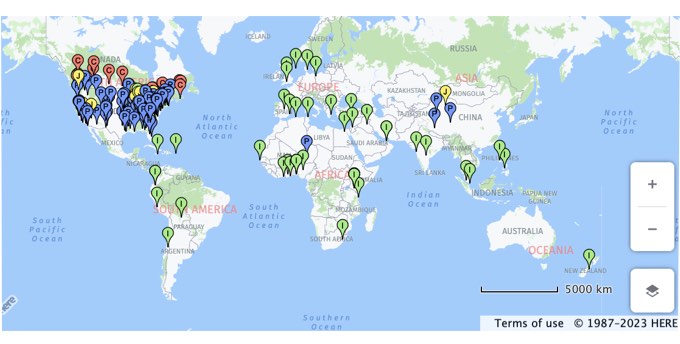
FOA has updated its online interactive map showing the FOA approved schools around the world. The new map shows the location of FOA schools, allows zooming in on a location and now includes a search function that allows locating a school by name or location. Once you locate a school, you can click on the school name and link to their website.
FOA's School Map
Latest FOA Book: Fiber Broadband (Paperback and Kindle)
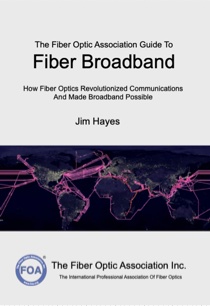 How does broadband work? Without fiber optics it would not work.
This book is not the typical FOA technical textbook - it is written for
anyone who wants to understand fiber broadband or fiber optics or the
Internet. It's also aimed at STEM teachers who want to include
communications technology in their classes. This book will try to
explain not only how fiber broadband works, but how
it was developed. It is intended to be an introduction to
communications technology
appropriate for a communications course at almost any level (junior
high, high school or
college,) for managers involved with broadband projects, or for anyone
who just wonders how all this stuff works.
How does broadband work? Without fiber optics it would not work.
This book is not the typical FOA technical textbook - it is written for
anyone who wants to understand fiber broadband or fiber optics or the
Internet. It's also aimed at STEM teachers who want to include
communications technology in their classes. This book will try to
explain not only how fiber broadband works, but how
it was developed. It is intended to be an introduction to
communications technology
appropriate for a communications course at almost any level (junior
high, high school or
college,) for managers involved with broadband projects, or for anyone
who just wonders how all this stuff works.The Fiber Optic Association Guide To Fiber Broadband Paperback ($12.95) and Kindle ($9.95) versions available from Amazon or most booksellers. Kindle version is in color!
Cross Reference Guide to Textbooks, Online Guide and Fiber U FOA Videos Guide.
FOA has a web page with resources on fiber broadband and the IIJA/BEAD funding programs.
FOA Newsletter
Sections
News Technical Worth Reading Q&A Training/FiberU Resoures Safety About
News
The Rumor Mill: No Real Supply Chain Problems For Fiber Optic Cable
Sources have told FOA that the year-long lead
times for fiber optics have disappeared; now you can get cables in weeks
or a month. The cause may be speculation. With all the discussion about
$billions of US money available for broadband, speculators started
ordering large quantities of cable expecting projects to turn on fast.
Perhaps they did not understand that federal money
flows slowly and even if money is available, projects take long times
to get planned and designed before any fiber gets installed.
Or have we forgotten the debacle of the "Dot Com
Boom and Bust" already? Fortunately, this bubble was caught in the early
stages - the last time it nearly killed the fiber optic industry.
US Department of Labor To Define And Track "Telecommunications Technicians"
Just who are fiber optic technicians? What
do they do? How many of them are there? These are questions we always
wanted to ask but the agency that tracks labor statistics in the US, the
Department of Labor Bureau of Labor Statistics (BLS) long ago put fiber
optics in with electrical linemen which made it difficult to get data
on fiber techs. FOA has been working with BLS for more than 15 years
trying to help make fiber data more relevant to our industry.
FOA has had a lot of recent conversations
regarding the nature of the fiber optic workforce and the widespread
concern about the shortages we face, and we've brought the CWA
(Communications Workers of America union) into the conversations with
BLS. It appears we have had some influence.
BLS recently told FOA that they are reclassifying
fiber optics into a new category called "Telecommunications Technician"
that will encompass techs working on both communications infrastructure
and equipment. In addition, BLS will expand their coverage in this
category to both landline and wireless communications systems,
recognizing the close relationship of the technologies.
The BLS website is supposed to be updated quickly, hopefully early this Fall.
Space-X Falcon Heavy Launches ViaSat-3 Satellite - First "Terabit Satellite"
 Space News
Space NewsOn April 30, a Space-X Falcon Heavy rocket launched a new ViaSat-3 satellite into orbit. This satellite is not small - it weights 6,400kg (14,000 pounds) - and must be the first "Terabit Satellite," offering 1,000 gigabits/second of capacity, triple that of its ViaSat-2 predecessors.
This ViaSat-3 will be in geostationary orbit over the Americas and two more are scheduled for launch to cover Europe/Middle East/Africa and Asia. It is expected to take several more weeks to deploy the satellite and ready it for service. (Space News)
Unlike the Low Earth Orbit (LEO) satellites of its own that Space-X is launching, large geostationary satellites like ViaSat-3 are actually much simpler because they don't move. Fast-moving LEO satellites are more complicated to track, communicate with, have much lower capacity and have short lifetimes. Large
geostationary satellites sit above one spot on the ground and cover large areas with their antennas. ViaSat can cover most of the world with these 3 satellites.
 ViaSat
ViaSatBut like the LEO satellites, geostationary satellites rely on ground stations connected on fiber optic networks - around 100 for ViaSat-3 - to provide communications to/from the satellite. Here's how they described their ground network:
"When ViaSat-3 Americas launches, all eyes will be on the sky, but while the satellite payload steals the show, the vast but mostly invisible ground network is the foundation of its success. Without it, a satellite would be merely a lonesome piece of space hardware.
The ground network plays the vital role of accepting signals from the satellite and managing traffic to and from the internet. It’s made up of a collection of earth stations, also known as gateways or satellite access nodes (SANs) connected to the internet by fiber optic cable. Antennas at each of the SAN sites serve as the connection between the user and the internet." (ViaSat)
A terabit of bandwidth is enormous - equal to hundreds of times as much as many ISPs and capable of supporting millions of users, as long as they are not all trying to stream HDTV at once. In fact, if users don't stream, continuing to use satellite TV services for entertainment, this is a viable option for most rural users.
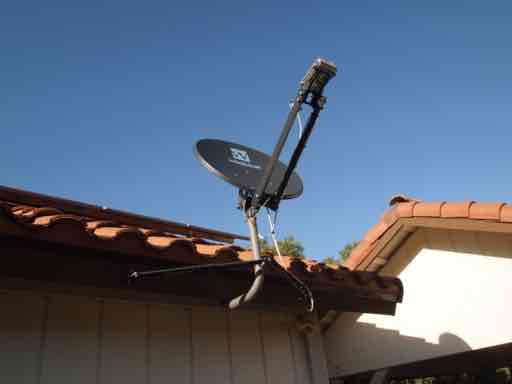
ViaSat antenna at FOA HQ in Fallbrook, CA, ~2012
That last statement was from personal experience. For many years, FOA headquarters was on a farm in rural San Diego County in California. When we moved in, we were able to get CATV and a cable modem, but as the last connection from the head end (literally), service as marginal. A few years later, we finally were able to get DSL on our phone line but it too was marginal.
When ViaSat launched it's first satellite, we signed up for the service. They installed this antenna on our roof and provided the equipment to connect to our network. We tested all 3 services - DSL, cable modem and satellite, and ViaSat proved to be the fastest and most reliable of the three services we had. If we still lived in a rural area, we'd still be a ViaSat customer.
For anyone living in a rural area, we highly recommend looking into this as a broadband option, becasue you may be waiting for years for fiber or even line-of-sight WiFi. Here is more information on ViaSat Internet service.
Charter Communications Hiring And Training Techs For Missouri Broadband Expansion
Charter Communications plans to spend $248 million to expand broadband coverage in Missouri according to a recent article in the St. Louis Post-Dispatch. $200 million will come from Charter and a further $48 million from US government funds from the RDOF program. The company plans to connect more than 61,000 homes as part of the program. Some areas where it is laying fiber have only 10 homes per mile, typical for small towns in the area.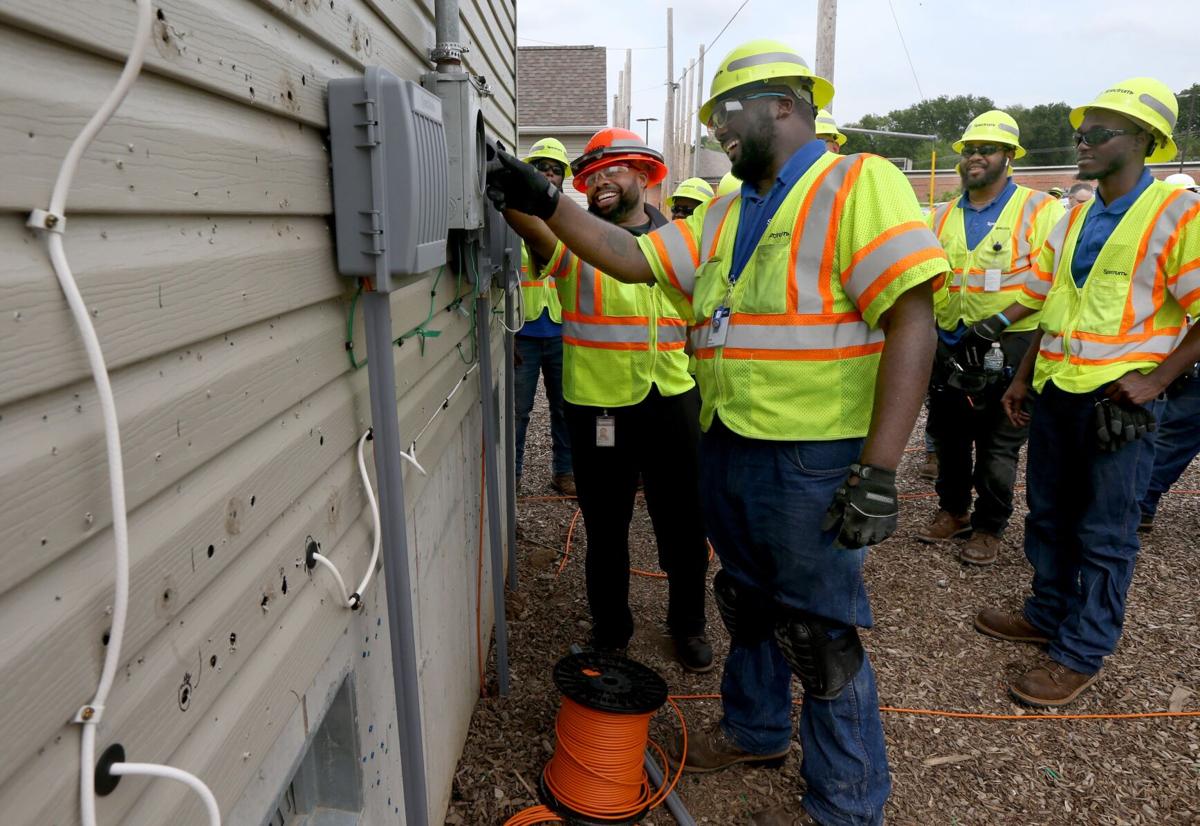
Techs in training at the Charter Spectrum training center in St. Ann, MO
Charter needed more techs to build this project, especially techs to do the FTTH customer premises installations. They did not require degrees for new hires. Pay starts at $20/hour and new employees get 14 weeks of training, a combination of classroom and hands-on practice. The training facilities has poles and even two houses to practice premises installations.
Hoisting Grip May Have Caused Fatality At Wireless Tower
Last December a tech working for Neticom LLC was killed while installing fiber to the antenna cables on an American Tower 200 foot tower in Texas. According to reports, the tech was working on the tower when a large hybrid FTTA (fiber to the antenna cable) with both fiber and heavy copper conductors broke loose, wrapping around him causing fatal injuries.There have been numerous reports of hybrid cables weighing two pounds or more per foot detaching from their hoisting grips or other rigging. However, this is the first known incident that caused a fatal accident, according to Wireless Estimator’s database.
Wireless Estimator identified shortly after the incident that a secured cable grip failure might have caused the death. Huber+Suhner provided the hybrid cable and factory-installed hoisting grip, which was later identified as a FIOMA grip.
If you are involved in FTTH installations, we suggest reading the both articles in Wireless Estimator.
Read the full report in Wireless Estimator and a followup article analyzing the failure of the hoisting grip.
What's Next In FTTH - Mergers & Acquisitions?
Steve Ross has an interesting article in Broadband Communities that speculates on this possibility in light of all the money flowing into broadband ISPs now. It's interesting reading.Read more in Broadband Properties
Are We Ready For Nuclear Power In Data Centers?

While scanning the presentations for a virtual meeting on data centers, we ran across this presentation description:
The Readiness of Nuclear in the Data Center Industry
As data centers continue to grow in size and quantity, the need for more and more electricity is inevitable. Additionally, the need for carbon free energy and the projected gap in electricity generation calls for alternative solutions. Hence, nuclear. Specifically, the idea of using Advanced Small Modular Reactors (SMR) is gaining popularity in conversation with data center operators and design engineers. This presentation will showcase the Readiness of Nuclear for Data Centers. The audience will learn about the different technologies, key players, regulations, and the head and tailwinds associated with deploying nuclear and SMRs. We will also look at the current and projected energy production of nuclear in comparison to other energy production fuels. At the end we will provide additional resources that will allow the audience to further expand their knowledge around this topic. In summary, the future will tell if we will see the first SMRs on a Data Center site generating its own power by the end of this decade.
Carsten Baumann - Schneider Electric
Tony Grayson - Compass Quantum
It leaves us speechless.......perhaps because your editor (JH) worked in the nuclear industry in the late 1960s when it was booming (bad joke, I worked for EG&G, the company that detonated the nuclear bombs) and I saw so many harrowing incidents in the business.)
Registration Open For ISE Expo 2023

ISE EXPO 2023, the OSP telecom conference, showcases the next wave of disruptive products, technologies and solutions for todays' and future networks. It's a conference for the professional who plans, builds, operates and maintains these networks. At ISE EXPO 2023 you can see, touch and demo new products, technologies and solutions for telecom networks.
Join ISE EXPO 2023 in Kansas City, Missouri, and experience why network professionals from around the globe attend our engaging seminars, commanding keynote presentations, solutions-based vendors and face-to-face networking.
More about ISE Expo 2023 (and early bird discounts)
Global Excavation Safety Conference 2024 in New Orleans

Global Excavation Safety Conference will be held in the city of New Orleans, Louisiana, from March 19-21, 2024. This is an opportunity for damage prevention & excavation safety professionals from all over the world to come together and learn, network, and share their knowledge and expertise in this vitally important field.
More info on Global ESC 2024
Looking for a good online fiber optic course? The FiberWizards Essentials - CFOT Prep Course could be a solution
How do you get new hires up to speed quickly? Continue training current employees and prepare them for the certification your customers are requiring? OJT - On-The-Job-Training. - is the usual answer, but an OJT program like the FOA's OJT-To-Cert program - requires a commitment from experienced techs and supervisors to ensure the techs stay on course.
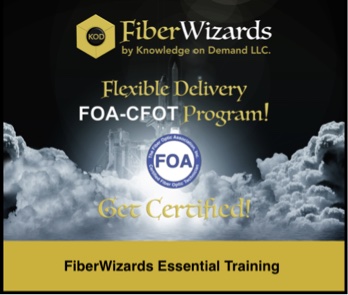
FOA Master Instructor and Director Jerry Morla has a solution that can work for most companies, the "FiberWizards Essentials - CFOT Prep Course." Students will get lots of flexibility to learn on their own terms with a very tailored and personalized experience including one-on-one coaching, virtual presentations, online modules, and access to a private Slack channel for support.
Students will get a lab kit when they join, to explore behaviors of light in fiber on their own. If the students need equipment to complete the hands-on part of the course, FiberWizards offers rentals of equipment and consumables kits for students within the Continental US.
For companies who need to train their fiber techs but lack the time commitment needed from their top techs, which is practically all of them, the FiberWizards course could be a very good - and cost effective - solution.
FiberWizards Essentials - CFOT Prep Course
Technical
Fiber optic technology, standards, equipment, installation, etc.
The FOA Update Page covers the new technology and applications we covered in this newsletter recently. Now you can review all that new tech at once.
Cross Reference To FOA Technical Reference Materials
The FOA has almost 1,000 pages of technical information on the FOA Guide,
100+ videos and two dozen online courses at Fiber U, all this can make
it difficult to find the right information.
Cross Reference To FOA Tech Materials
To help this, we have created a cross reference guide to the textbooks,
Online Guide and Fiber U courses, all the FOA technical information.
Besides the textbooks, online Guide and Fiber U, each section of the
Guide also includes links to the 100+ FOA videos available.
Cross Reference Guide to Textbooks, Online Guide and Fiber U
We have also rearranged the 100+ FOA videos in similar categories on the Contents Page of the Online Guide, making the videos, especially the lectures, much it much easier to find a video on a particular topic.
FOA Videos Guide.
|
Sponsored Content
 OptConn
is a value-add re-seller of optical connectivity products, services and
solutions. With over 30 years of experience in the fiber optics
industry we are here to serve your requirements from fiber optic
training with FOA certification to products, materials and supplies. OptConn
is a value-add re-seller of optical connectivity products, services and
solutions. With over 30 years of experience in the fiber optics
industry we are here to serve your requirements from fiber optic
training with FOA certification to products, materials and supplies. We have partnerships with industry leading
manufacturers to support your installation, splicing and testing needs.
Our goal is to guide, support and recognized our client’s requirements. |
Converting CATV HFC to FTTH PON
For many years, cable operators have been building and maintaining HFC (Hybrid Fiber Coax) networks. HFC is a broadband network that enables triple-play services - CATV, IPTV, Internet, telephony, etc. HFC began when AT&T developed the distributed feedback (DFB) laser, a high power laser that was capable of high frequency conversion of signals with minimal distortion. This permitted CATV operators to convert analog frequency modulation (FM) CATV signals to optical systems, allowing them to extend their CATV networks well beyond the limits of traditional coaxial cables.About the same time, a network was developed that allowed Ethernet signals to be converted to FM and sent as data in place of a channel on a CATV system. Since Ethernet was the basis of the Internet, this allowed CATV systems to become providers of Internet service, offering much higher speeds than the telephone lines in current use and always-on service. CATV systems quickly became the dominant provider of Internet service.
This service became standardized in 1997 as DOCSIS – Data Over Cable Service Interface Specification. As the Internet grew, so did the DOCSIS standard. In order to keep up with user requirements, CableLabs, the research arm of the CATV industry has constantly upgraded the DOCSIS standard.
Upgrades to DOCSIS standards require major changes in the HFC network due to frequency range expansion. In addition to replacing electronics, major changes are required in the coaxial part of the HFC network, such as replacing passive equipment (RF splitters) and active equipment (broadband amplifiers and optical nodes). These are very big changes that many operators are not prepared for. Because of this, many cable operators are starting to build FTTH with passive optical networks (PONs).
Vladimir Grozdanovic, a graduate electrical engineer for telecommunications with more than 10 years of experience in access networks (HFC and FTTH) in large cable operators in Serbia (SBB and Jotel), has written for FOA a comprehensive explanation of how system operators are converting HFC to PON for FTTH.
You can read "Migration from CATV HFC To PON" in the FOA Guide.
CATV CableLabs Releases Architecture Specifications For Coherent PON
CableLabs, the R&D lab of the CATV industry has been leading a project to greatly enhance passive optical networks, PONs, using coherent transmission technology. Coherent technology was first introduced for long haul links, primarily submarine cables, because it allowed longer reach and higher speeds, but at a high cost per link. Like most technologies, given time and production experience, costs fall rapidly and coherent has not been an exception. In fact, costs dropped so fast that it's now being pushed into data centers and municipal networks.We first reported on CPON - CableLabs name for their Coherent PON - in this newsletter in August 2021, we noted it was a major step up from GPON or the several 10G PON standards, with 10 times greater speed, higher split rations and longer reach. With the publication of the specifications for CPON, CableLabs confirms the advantages of CPON. Specifications in the document include capabilities of a 512:1 split ratio at 20 km, 1:64 at 50 km, and 1:16 at 80 km. In urban/suburban areas, it means many more subscribers per port and in rural areas, longer reach. Furthermore, the wavelengths chosen allow CPON to coexist on cable plants now supporting GPON or XGS-PON (10G).
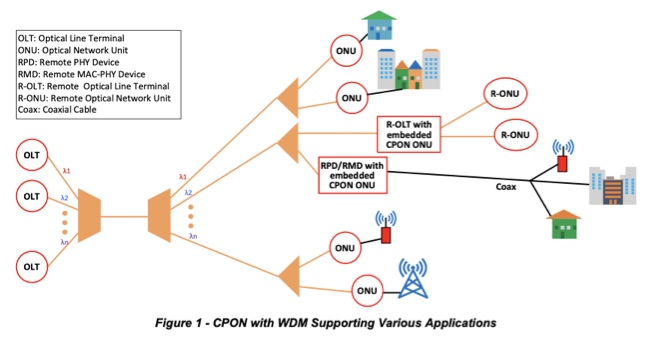
As you can see from the diagram of CPON architecture from the specification document, the intent is to use CPON for applications beyond simple FTTH. The bandwidth and reach available make it useful for wireless and other high speed point-to-point networks as well.
This is just the beginning of creating a CPON working document, only covering network architecture. Full specifications of transmission specifications and protocols will require more development as well as lab and field testing.
Download a copy of "Coherent Passive Optical Networks 100 Gbps Single-Wavelength PON, Coherent PON Architecture Specification: CPON-SP-ARCH-I01-230503"
Installation Tool For Single Fiber Cables
Pul-R Technologies has created an interesting tool to assist in installing fiber optic - and copper - cables. "Helipuller(TM) is a simple plastic gadget that protects the connector, grips the cable and allows pulling a patchcord safely, especially through walls often encountered in FTTH installations.
The Helipuller for an SC cable is shown above. It protects the connector and the helical grip holds the cable for pulling with up to 30 pounds of tension. Accessories incliude a tip to attach a pull rope or a stiff rod for pulling.

Installation is simple - drop the connector in the head of the gadget, fit the cable in the helical grip and you are ready to pull the cable. After pulling, release the cable and use the grip again and again.
More information: Pul-R Technologies
Problems With High Fiber Count Cables?
We're hearing rumors that these cables are getting fibers broken during installation with the possible cause(s) being exceeding bend radius or pulling tension, using improper installation equipment or maybe even the cable designs. We're investigating this and will report back in the near future. But please ensure installers follow manufacturer's recommendations carefully.Confusing Jargon - Colored or Gray Fibers
A press release we were reading recently used two
terms we were not familiar with - colored and gray fibers. After
discovering the terms were unknown to some others we asked, we searched
and found some references to the terms in articles in the Middle East.
Colored fibers appear to be fibers used with DWDM systems and grey
fibers are fibers with only one wavelength. Technically using the word color instead of wavelength is incorrect. Color (or colour if you prefer) is a characteristic attributed to light in the range of sensitivity of the human eye and the human eye cannot see the infrared wavelengths used in fiber optics.
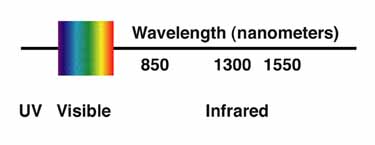
Likewise, gray is a term for a "color" between black and white - black being no color at all and white being all colors - often referred to as a neutral or achromatic color.
A single color - or wavelength - would be more properly described as monochromatic, except that the term also refers to black and white photography.
Rather than color and grey, we'd suggest DWDM and mono, but who knows what the industry will prefer.
Flexible Ribbons + Air-Blown Fiber (ABF) = Big Advantages for ABF
AIr-blown fiber has been around for over 30 years now and is a well-proven technology. The concept is simple - install plastic tubes and blow individual fibers into the tubes. Unlike cables, upgrades are simple - blow more fibers into the tube or blow current fibers out and new fibers in.The new flexible ribbon technology that has led to major density advances in conventional cables is now being used by Sumitomo in ABF. This has two advantages - you can now install more fibers in a tube, up to 72 now with more density being developed - and the advantages of ribbon splicing for termination - saving about 80% in termination time.
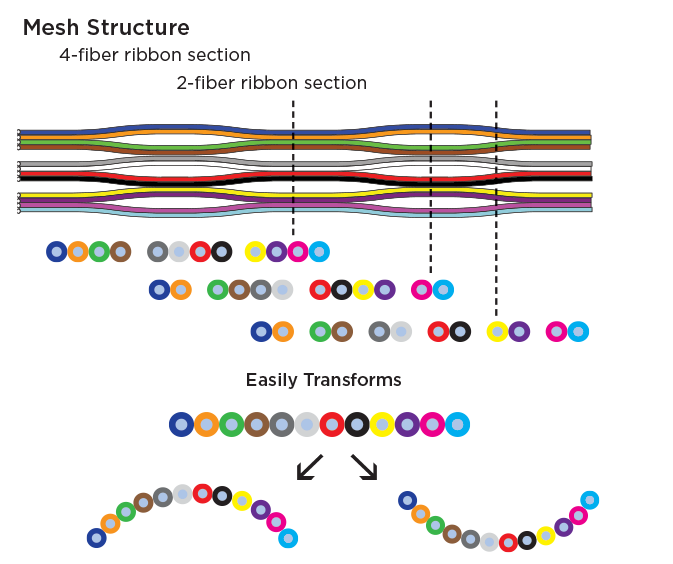
Supporting products are available too - ribbon breakouts to connectors makes termination easy and fast. Bundles of tubes, even with optional armor for protection, make installing hundreds or thousands of fibers simple.
ABF is a technology that should be considered for premises cabling even in data centers as well as one of the original reasons it was developed, FTTH.
Read more from Sumitomo.
Special For High Level Techs And Engineers:
Standards and Testing Photonic ICs
Point to Multipoint Networks at Infinera
Managing Fiber Optic Projects - The Gantt Chart
(With An Excel File To Make Your Own)
The most common way to track projects is the Gantt Chart, a
chart of activities that tracks the progress of projects along a
timeline. each activity is represented by a bar and the position and
length of the bar represents the starting date and duration of the
activity. This allows you to see what activities are needed for the
project, when the activities start and end so it can be used to track
the progress of the project visually. Here is what a Gantt Chart for a
fiber project might look like:
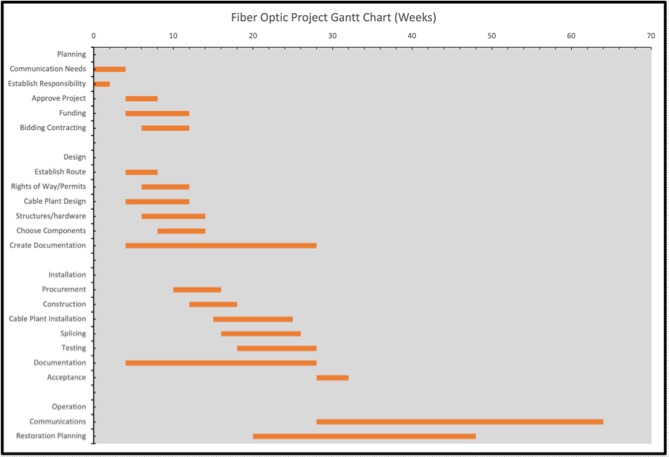
You might remember an article in the FOA Newsletter in April 2022 or the FOA Guide page on Project Management about the timing of a fiber optic project where we showed the progression of steps in a project like this:
The Gantt Chart above is simply this list converted to a Gantt Chart using a Microsoft Excel spreadsheet. You can download a copy of the FOA Gantt Chart spreadsheet (xlsx file - 16kB) and use it to create your own Gantt Chart for any project. All you have to do is to input your own data and change the activity names as necessary. You can also follow the directions from Microsoft to create your own version.
More Help On Color Codes (Including Copper Cabling And Fiber Optics)
The FOA has created a print-your-own pocket guide to fiber
optic color codes. It has
color codes for fibers and buffer tubes, connectors and premises cables
inside and on the back, QR codes to take you directly to the FOA Guide
and Fiber U.

The FOA
Guide page on Fiber Optic Color Codes is one of the most read pages on the FOA
website and the Fiber Optic Color Codes minicourse on Fiber U very popular also.
Here's a do-it-yourself FOA Guide To Fiber Optic Color Codes card.
Just download the PDF file, print it on a color printer and fold it up
as shown. Then you have your own pocket guide to color codes. Make a
bunch for your co-workers too.
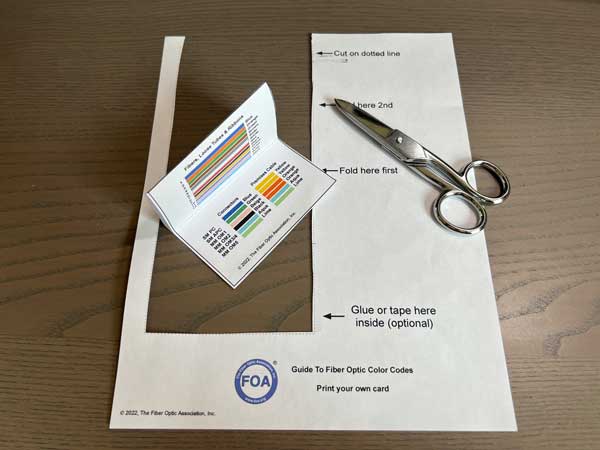
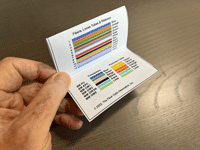
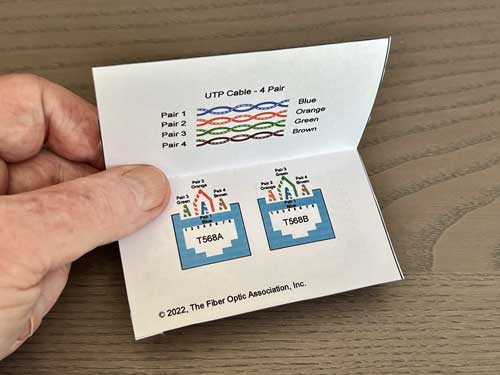
Then we realized that many of your also do structured cabling work, so it was a natural to add a Color Code Guide for UTP copper cabling in printable (below) and electronic (above) versions.
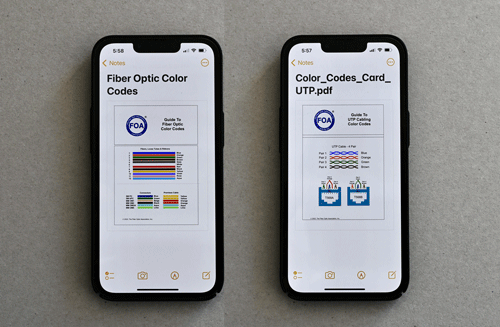
But we did not stop there. We know how many of you use your mobile devices on the job, so we created a version of the Color Code Guide you could download and use on your smartphone or tablet. It's a PDF file, so you just download it and save it on your device and it will be with you always.
Here are the links to download your own FOA Guides to Fiber Optic Color Codes
FOA Guide to Fiber Optic Color Codes (print your own version) PDF
FOA Guide to Fiber Optic Color Codes (electronic version for your smartphone, tablet or PC) PDF
And For UTP Cabling
FOA Guide to UTP Cabling Color Codes (print your own version) PDF
FOA Guide to UTP Copper Cabling Color Codes (electronic version) PDF
Warning For Techs Doing OSP Restoration
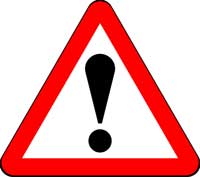
FOA received an inquiry about whether techs working on restoring OSP links should be concerned about eye safety if the link used fiber amplifiers. To answer this question, we had to do some research on fiber amplifiers. The short answer is YES, you should be concerned. The long answer is more technical and includes details that every OSP tech needs to know.
See "Fiber Amps And Restoration" in the FOA Newsletter Archives..
Try The FOA's Online Loss Budget Calculator
FOA has written many articles about loss budgets, something everyone involved in fiber optics needs to know and needs to know how to calculate. We've created a online Loss Budget Calculator that does the work for you. Just input your cable plant data and it calculates the loss budget. It works on any device, especially smartphones and tablets for field use and even allows printing the results.
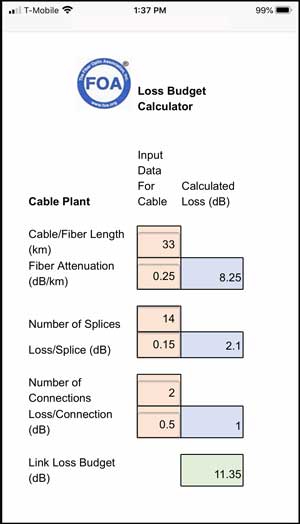
Bookmark this page (especially on your smartphone): FOA Loss Budget Calculator Online
Worth Reading
Each month we read hundreds of newsletters and online articles. These are the ones we think you will find "worth reading."
FOA has a web page with resources on fiber broadband networks and the IIJA/BEAD funding programs.
Cross Reference Guide to FOA Textbooks, Online Guide and Fiber U
FOA Timeline of Fiber Optic History and the new FOA video "The History Of Fiber Optics"
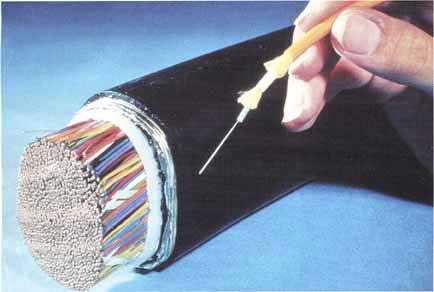 AT&T PR photo from the mid 1970s
AT&T PR photo from the mid 1970sThe FOA's History
Worth Reading (And
Watching):
June 2023
Bringing FTTH Broadband to Remote and Rugged Areas - Broadband Properties - By Michael A. Solitro, CEO of Sertex Broadband Solutions.
NTIA Says State Muni-Bans Won’t Delay BEAD Funding - ILSR says "Maybe"
AT&T claims satellite-direct-to-phone deal with AST SpaceMobile in FCC waiver filing - Urgentcomm.com
AFL Creates Video Classroom Online The AFL Classroom showcases products, solutions and AFL value propositions
US Proposes Designating Portion of Radio Spectrum for 5G in the Americas Nextgov.com If approved, the proposal could enable countries in the Americas to use the band to deploy 5G mobile services.
Significant progress reported on California middle-mile network - CA Dept of Technology
Recent Case of Severe Microwave Syndrome Reveals Problems With 5G - Epoch Health -
One woman's recent illness highlights the issue of only considering radiofrequency radiation's thermal effects
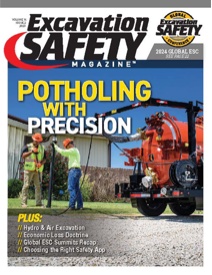
The Summer edition of Excavation Safety Magazine is online
May 2923
Do You Believe In Magic? Sufficiently advanced technology is indistinguishable from magic. Jim Hayes's column in March/April ISE Magazine.
After federal investment, supply chain jams and labor shortages still hinder tribal broadband access - Marketplace on Public Radio
Fiber To The Office (FTTO) On A College Campus In The Netherlands - NEXANS
Special For High Level Techs And Engineers:
Standards and Testing Photonic ICs
Point to Multipoint Networks at Infinera
April 2023
Telegeography Submarine Cable Map 2023 - You can also buy copies - Telegeography
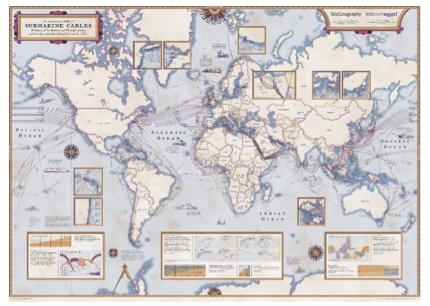
Taiwan suspects Chinese ships cut islands’ internet cables - Los Angeles Times
Broadband Communities Summit Conference, Houston, May 1-4, 2023
March 2023
CABL® (cabl.com) serves the business needs of the Broadband industry (including traditional cable TV, fiber, telecom and satellite providers) with employment listings, classified ads, discussion forums, and more. A contractor told us it's where they find lots of opportunities for subcontracting.
The State of the Network in 2023 (eBook) Telegeography
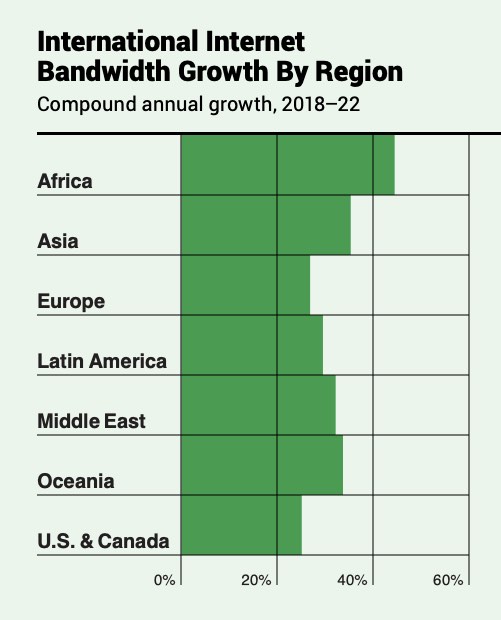
From Telegeography' The State of the Network in 2023
The Secret to Future Proofing, by Jim Hayes, FOA President, ISE Magazine
Open Access Conduit in West Des Moines, Iowa Brings Google Fiber, Choice to City Residents (Dig once - buy conduit!) ILSR Community Networks
Emergency Repair of Subsea Fiber Optic Cable in Anguilla (LinkedIn)
February 2023
Friday the 13th Mapping Challenge Deadline Highlights Failed Process - The new national broadband map challenge process - crucial for future infrastructure funding - looks to have been hamstrung by critical lacking information from the start, and that has us worried.
Ask The Experts: What Defined The Industry in 2022? Telegeography
Review Telegeography's Presentation On the 2022 Fiber Optic Market
January 2023
The 45 Year Old Overnight Sensation - article by FOA President Jim Hayes in ISE Magazine (Read the complete Nov/Dec issue of ISE Magazine here.
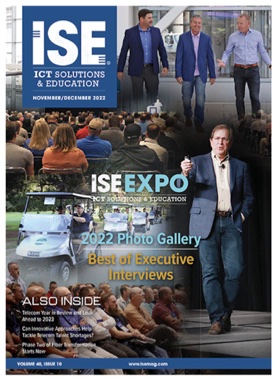
Going
the distance: What you need to know about breaking the 100-meter
distance limitation Cheating on the standards for UTP cable - CI&M Magazine
FCC Requires Broadband Providers to Display Broadband Nutrition Labels not
nutrition labels on the product's "high fiber content" but key
information consumers want−prices, speeds, fees, data allowances, and
other critical information.- Broadband Communities
ESRI has created an ebook on GIS location technology for telecom. Use the link to download the book.
The First Transcontinental Telephone Line began operation on July 29th in 1915 - 3400 miles between New York and San Francisco - required over 100,000 telephone poles! Wonders of World Engineering
Conocimiento Esencial: ¿Por qué la fibra óptica? creado por FiberWizards
Recruiting And Training Today's Fiber Optic Workforce - Learn the fundamentals to recruit and train new fiber optics - by FOA's Jim Hayes in ISE Magazine.
Explosive Fiber Broadband Expansion Drives Need for Fiber Technician Training Programs - Telecompetitor - As fiber sees record-setting deployment levels, the demand for fiber optic technicians is stronger than ever.
Google Video On Their Undersea Cables YouTube Slick but interesting video on how undersea cables are designed, built and used.
Construction Without Disruption - FOA President Jim Hayes' column in ISE Magazine
Fiber Optics Installed By The Lowest Bidder - ISE Magazine - by Jim Hayes, FOA President.
Building Broadband During Component and Worker Shortages
- Broadband Communities - Completing broadband builds requires
competent fiber optic techs, but training them requires understanding
how they learn - by Jim Hayes, FOA President.
Worth Reading - Magazines, Websites and Newsletters
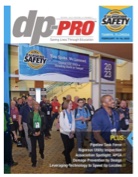
The latest Issue of dP-PRO, the "call before you dig" magazine, is online.
dpPro sponsors the annual digging safety conference each year - next year in Tampa.

New Fiber Optic Magazine In Spanish
Todo Fibra Optica is a new digital magazine in Spanish for fiber optics in Latin America and South America. Jose Enriquez, editor of Todo Fibra Optic magazine has many years experience in the fiber optic industry so he knows the industry well. FOA will be working with him to share our extensive technical materials in Spanish.Read their newsletter here. It is now available online in English and Spanish.

All issues and subscriptions.
Contact:
José Manuel Enriquez Mora, Editor
Todo Fibra Optica LLC
https://todofibraoptica.com/revista-ediciones/
+52 222 302 8224
jose.enriquez@todofibraoptica.com
RTI Telecom Magazine from Brazil, in Portuguese. A revista RTI do mês de abril já está disponível online e recomendo a leitura de alguns artigos:
1995-2020 - FOA's 25th Anniversary!
As part of celebrating 25 years of serving the fiber optic industry as its primary source of technical information and independent certifying body, FOA thought it appropriate to create a short history of the organization and how it has developed to help the fiber optic industry. We also wanted to recognize the contributions many people have made to the organization over the years that made FOA what it is today.The FOA history is now archived on the FOA website where you can read it anytime or link to it. Updated info - dB, total internal reflection and science projects,
Worth Reading - News Summary - Past Links Worth Repeating
1983 Video of AT&T's First Test Of A Submarine Cable System From the AT&T Tech Channel archives (worth exploring!)
Richard Epworth's Optical Fiber History from his work at STL from 1966 with Charles Kao.
Communications Systems Grounding Rules: Article 800 provides specific requirements by Michael Johnston, NECA Executive Director of Standards and Safety in EC Magazine
US Broadband Coverage By Service Provider from the FCC
How To Build Rural Broadband, Learning From History
In the August 2021 FOA Newsletter, we published a lengthy article on rural broadband and compared it to rural electrification in America in the last century. Much of the comparison was based on an article written in 1940 by a USDA economist, Robert Beall, called "Rural Electrification."
If you are interested in or involved in rural broadband, we recommend you read the article "How To Build Rural Broadband, Learning From History" in the August 2021 FOA Newsletter and read the Beall article also.
Recycling Fiber Optic Cable - Contact:
Steve Maginnis
LD4Recycle/ CommuniCom Recycling
(Visit website)
sm@LD4Recycle.com
803.371.5436
Sumitomo's Ribbon Splicing Guide - download from one of the leaders in splicing.
"Who Lost Lucent?: The Decline of America's Telecom Equipment Industry"
This is a MUST READ for managers in telecom or any industry!
This long and well-researched and annotated article in American Affairs Journal should be mandatory reading for every high level manager in a telecom company - or any other company for that matter. To summarize the article, today, America has no major telecom equipment company and fears the major suppliers of equipment who are all foreign, especially the Huawei from China. This article explains how America got into this deplorable state.
OFS also has an excellent website and blog of tech articles worth browsing.
IEC 60050 - International Electrotechnical Vocabulary - An extensive dictionary for fiber optics in English and French. Highly technical - this is one definition: "mode - one solution of Maxwell's equations, representing an electromagnetic field in a certain space domain and belonging to a family of independent solutions defined by specified boundary conditions"
If you are interested in restoration - aren't we all? - you should also read this article in dpPro magazine by FOA President Jim Hayes: Damage Protection Requies Looking Overheas As Well As Underground - dpPRO Magazine - about the problems with aerial cables. His previous article for the magazine was New Techniques for Fiber Optic Installation.
How much fiber optic cable is
manufactured each year? CRU Reports -
unsurprisingly China is by far the largest market
today
The Institute for Local
Self-Reliance weekly newsletter has
lots of interesting articles and links.
Universal access to broadband
is a cornerstone to a strong economy,
Achieving universal access will require
community partnerships. by Alfreda
B. Norman, Sr. VP, Federal Reserve Bank of
Dallas
FIBER TO THE FARM: The
co-ops that electrified Depression-era farms are
now building rural internet. Be sure to check out
the high-tech equine installation equipment.
Next Century Cities Newsletter
- News from cities around the US
including Detroit and New York plus small
Infrastructure Get Some Respect, NY TImes "On Tech" "The magic of the internet requires a lot of very boring stuff behind the scenes. "
DIRT Report On Damage To Utilities Common Ground Alliance (CGA) annual DIRT report provides a summary and analysis of the events submitted into CGA’s Damage Information Reporting Tool (DIRT) for the year 2018. The complete report is available for download here. In addition, there is an interactive dashboard that allows users to filter the data more by factors contributing to damages.Structured Cabling News - a website and weekly newsletter about cabling.
Fiber Trivia From Corning.
The Future Of Work Is Skills - So Stop Worrying About Degrees - The reality is the future of work is about skills, not just degrees. (FOA Newsletter Feb 2020)
The job market is hot. So why
are half of U.S. grads missing out?
VIAVI Books On Fiber Optic Testing (2 volumes) - They're back!
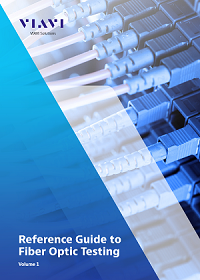
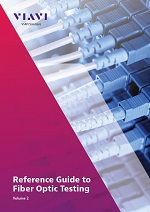
Besides the FOA reference materials, two JDSU/VIAVI textbooks, Reference Guide to Fiber Optic Testing, Volumes 1 and 2, were used as references for some of the FOA courses and are recommended for instructors and students. The books are available from VIAVI as eBooks and the everyone should download them and recommend them to others.Download yours now. Volume 1. Volume 2. Viavi Books
Ciena's Submarine Cable Handbooks (4 to download)
Guidebook To MPO Testing OptoTest offers this complete guide to MTP®/MPO testing. In this guide, you will learn all there is to know about the different test methods, equipment options, troubleshooting, and best maintenance practices to ensure that you have the best testing experience. Go here to download the book.
50th Anniversary of The Development of Low Loss Fibers A history of the development of low loss fiber, a fascinating story by Jeff Hecht on the OSA (Optical Society of America) website.
How OFS Makes Fiber
Interesting YouTube video on how fiber is made. Perhaps a little too much "show biz" but fascinating. If you have ever seen fiber manufacture, look at this video. You will be amazed at how big preforms have become!
The True Cost of Telco Damages (what backhoe fade or target practice can cost)
Rural Electric Cooperatives: Pole Attachment Policies and Issues, June 2019.
Clearfield-FOA Certification Training Clearfield is now offering their customers an FOA CERTIFICATION course. This course provides a basic understanding of fiber optic technology, as well as Clearfield product knowledge and how Clearfield’s integrated product systems work together in a fiber network.
Substandard Contractors - Fiber Optic Knowledge Doesn't Always Trickle Down (EC Mag)
Q&A
When readers ask us questions, we genrally refer them to FOA
resources where they can find the answer to their question and many
more. We first send them to the FOA Guide
which is the table of contents for the FOA technical resources. There
they can find pages indexed by topic and a search engine for the FOA
website. It also links them to FOA videos and courses on our free online learning site Fiber U.
The FOA Fiber FAQs Page (FAQs = frequently asked questions) gathers up questions readers have asked us (which first ran in this newsletter) and adds tech topics of general interest.
Good Question!
Tech
Questions/Comments From FOA Newsletter Readers
More Q&A in the FOA FAQs Page
June 2023
PON Testing
Q: When testing upstream back to the CO on a PON, how can we get a good OTDR trace if the primary splitter (nearest one to ODF) has a 2:8 split ratio rather than the usual 1:8?
A: It's just like looking at a 1X2 downstream - you will see the combined traces of each fiber. If the second port is for testing, it may be short and connector, so it will not affect the longer trace very much. If it's the same length and used as a spare, you need to test each fiber downstream to the splitter. Nothing is easy with OTDRs and splitters!
Fiber Splicing Cost
Q: What is the standard of costing for fiber splicing and terminations? Is it per core / per splice or per each cable end irrespective of the number of cores?
A: That is a very hard question to answer, other than to say ”it depends. ” The number of fibers is definitely a factor because each fiber must be stripped, cleaned, cleaved and spliced then placed in the splice tray.
It also depends on:
- Single fiber or ribbon splicing?
- Type of splice closure
- Type of cable (loose tube, ribbon, flexible ribbon, high density, armored, ADSS, etc.)
- Installation: aerial or underground
- Location: urban or rural
- Set up time (same for low fiber count cable as high fiber count cable)
FTTH Network Design Course
Q: I would like some advice on how to develop a responsive curriculum involving FTTH network design.
A: FOA has lots of free resources you can use. Fiber U offers free online courses in FTTH and Fiber Optic Network Design that can be used to develop your courses using blended learning - online and classroom work blended. The courses cover all aspects of these topics and include lesson quizzes. The Design course includes a dozen case studies ideal for student assignment, including one on FTTH. You can also begin with other courses like Basic FIber Optics and Outside Plant Fiber Optics and Outside Plant Construction. The Fiber U courses draw on material in the FOA Online Guide where you will find many other pages of useful information.
Teaching a course on FTTH and FTTH Network Design is easy using this material. The Design labs don’t require equipment; just use the case studies we provide and develop more of your own.
Color Blind Fiber Tech
Q: Can someone who is color blind become a fiber tech? Aren't all cables color coded?
A: There are various types of color blindness (remember all the charts with different dots at the eye doctor’s?) that don’t necessarily mean you cannot distinguish the color codes used in fiber. Only a test with actual components would really tell that - and remember that colors are different from some processes - some are faint and some brilliant - that may affect how they are perceived. The variation among colors can often still be distinguished by color blind people depending on the situation. I personally would not discourage anyone from taking a course because they are color blind. They can check their ability to distinguish colors used in fiber optics here.
Markers Required For Underground Fiber Optic Cables?
Q: Are signs required for underground cables like fiber optic cables? Are they required to have signage so people don’t dig them up or damage them?
A: In the US the answer is NO. There is no Federal or State law which requires marking anything other than hazardous liquids and gases. It is purely a business decision or a moral decision to invest in signs/markers to protect buried fiber. If a fiber gets cut it can disrupt 911 service and all kinds of vital communication related to hospitals, air traffic control, etc.
May 2023
Reflectance Testing
Q: Do you know whether anyone has compared the reflectance measurement determine by the OTDR calculation to that make with a reflectance test set?
A: Measuring reflectance/return loss is a complex task requiring measurement over a high dynamic range with limited accuracy. We devoted a 15 page chapter to it in the testing book. The problem is establishing a reference - like most other tests - but the uncertainty is probably no better than +/-3dB.
Here is a place where the OTDR measurement is probably the preferred method because the test is made with mated connectors compared to the backscatter background and the meter/source/spitter measurement has to compensate for cable lengths and the reflectance from the far end of the mated cable which needs termination (dip in index matching fluid) to prevent that reflectance from affecting the measurement.
Testing OM2/3/4 Multimode Fiber
Q: Is there any loss concerns when mating an OM2 fiber to an OM4 fiber (vs using the same type only).
The question applies to both use of an LED source and an VCSEL laser source. We can assume it is only for short fiber lengths (< 25meters)
A: OM2, OM3 and OM4 fibers have the same basic specifications. Based on this specification, the two fibers are geometrically identical and there should be no difference between them.
However, about 10 years ago, multimode fiber was introduced with bend-insensitive structure. https://foa.org/tech/ref/fiber/BIfiber.html Today almost all multimode fiber is bend-insensitive. Earlier MM fibers, including the OM2 fibers, are not bend-insensitive. Unlike SM fiber, where bend-insensitive singlemode fiber is given an different designation - G.652 becomes G.657 - multimode fiber is not differentiated between regular and bend-insensitive, cables are not marked, and it takes a knowledgeable tech with a microscope to tell the difference.
Until recently, testing standards called for test reference cables to be non-BI fiber because the early BI fibers simply added a lower index trench around the core to capture the lost modes which gave them a larger core diameter and higher effective NA and these fibers did not respond the same way to traditional mandrel wrap mode filters - in fact the specified mandrel wrap had virtually no effect at all. When non-BI fibers were tested with BI fibers, the effective core diameters produced directional loss effects. Over a decade, MMF manufacturers learned more about BI fiber structure and modified the index profile of the fiber to essentially make BI fiber about the same as non-BI fiber. In addition, mode control was changed to encircled flux controlled sources instead of mandrel wrap mode filters, which was more effective with both fibers.
So recently, MM testing standards have changed. You can use whatever 50/125 fiber you have to test OM2, OM3 and OM4 fiber.
Fiber On Road Markings?
Q: Can this work? Intergrate fibre into road marking ie white line/double line . Have a very low profile skid resistant duct that replaces the line markings.
Every street can have a fibre connection from the main backbone. The fibre can be used to feed line markers for traffic, warn of impending incidences and used for colour coding speed limits.
A: Google Fiber tried something like that in Louisville, KY. It did not turn out well.
https://www.foa.org/foanl-3-19.html
Starting A FIber Business
Q: Where would I take a workshop about how to start my own fiber business? How to start, what you need, where to buy, what machinery? Anything like that exist?
A: Starting a fiber optic business is basically like starting any other business. There are many local classes for business owners about starting and running a business at community colleges or other educational groups. If you are already involved in fiber optics, you should have contacts for tools. equipment and components. If you are not familiar with the fiber optic business already, we’d recommend you get a few years experience in the field first.
Course On OSP & OSP Construction
Q: Do you offer a course geared towards newer OSP engineers that covers the different network architecture options, aerial vs. underground network topologies, splicing diagrams, theory, equipment, jargon, etc. ?
A: FOA has courses on Fiber U on both OSP & OSP Construction. Many of our schools offer courses on Design or OSP installation, but we do not have many that offer OSP Construction courses due to the facilities needed. We have a program in process but few schools have the resources to offer it.
April 2023
Electromagnetic Interference
Q: Is there and electromagnetic interference with optic cables?
A: The fiber is glass and the cable is plastic, neither of which are affected by electromagnetic interference. There is a cable used in electrical transmission lines called OPGW- optical power ground wire - that has fiber inside a wire conducting high voltage - doesn’t bother the fiber at all.
Bandwidth Issues
Q: We are having transmission problems on long fiber runs with mixes of fiber types. Ideas?
A: Perhaps the problem is simply the total bandwidth of the fiber. If the long spans are G.652, it will probably have CD and perhaps PMD issues. It’s worth doing fiber characterization tests on it. See this page in the FOA Guide: https://foa.org/tech/ref/testing/test/CD_PMD.html If you are over 100G, coherent transmission might overcome the problems with bandwidth.
Can we get the following information from OTDR tests?
1. Attenuation
Yes, see https://foa.org/tech/ref/testing/OTDR/OTDR.html
2. Chromatic dispersion (Need some help )
On some special OTDRs with mulitple wavelengths - see https://foa.org/tech/ref/testing/test/CD_PMD.html
3. Polarisation mode dispersion (Need some help)
Not on any we know about. Also see https://foa.org/tech/ref/testing/test/CD_PMD.html
March 2023
Fiber Optic Network Maintenance
Q: I am in the middle of building a set of documents for Fiber Optic Internet Services and one of the areas needed is a template for supporting the outside plant facilities. Might there be a template of must-haves for any service provider or municipality to have as part of their maintenance agreements once the network build and construction is finished?
A: That’s a good topic to cover in agreements. When people ask us what maintenance fiber optic networks need, we usually tell them “build it, lock it up and forget it.” In other words what some people have suggested for maintenance for fiber optic networks, like periodic testing or cleaning of connectors, is more likely to cause damage than help. Preparing for restoration, however, is vitally important. Every day several fiber optic cables are cut by other construction.
Here are a few links from the FOA Guide that may be useful:
Fiber Optic Network Management (For Managers)
User's Guide To Fiber Optic Networks
Maintenance
Restoration (planning & implementing)
Converting RF To Fiber
Q: I would like to convert our SATCOM System to RFoF. Currently we use our antenna to receive from 2 RF ports on the antenna, DC-6Ghz, and 6-20Ghz. We also have other antennas that are configured to do DC - 1Ghz, and 1-Ghz. Currently we are doing testing with an RfOptic RFoF converter on the 1-6Ghz with great results. Currently we are just doing lab testing as our operational systems are all RF with COAX.
A: Converting from coax to fiber is generally easy because the application is widespread and components easy to get. The model for what you are doing might be the Fiber to the Antenna (FTTA) application for the wireless services. See this for an example: https://www.opticalzonu.com/solutions/uhfandvhf/
Documenting Fiber Optic Cable Plants
Q: I am looking for information or training materials on documentation standards for OSP cable. We currently have a number of large backbone cables along with mid span cables. I know companies like the phone company labels each cable with a number and terminals off of the mid span drop with the specific pair numbers. Is there a standard way to label each cable, mid span cable, splice box, terminal, etc.?
A: The usual way is to document every fiber in every cable with a fiber designation, color code and connections on each end. There are some standards on numbering schemes but most companies I know use their own designations created as they got started. There are software packages that will do this work, simplifying the process,
February 2023
FOA Technical Materials Updates
Q: How often are FOA courses (such as CFOS/D) updated? And when they get updated, what happens to those who would have done a previous version?
A: The FOA knowledge base is updated continuously, reflected first in the FOA Guide online (FOA Guide), then in the curriculum materials for courses at our FOA Approved training organizations and Fiber U (Fiber U). Textbooks are updated every few years, generally just tech updates, but sometimes with major additions like the large section on OSP construction added into the OSP book.
If you took your certification a few years ago, there are new courses at Fiber U and a FOA Update Page that we use for new information that was first published in the newsletter. And of course reading the FOA Monthly Newsletter FOA News will help keep you up to date on fiber optic tech and applications.
Measuring Short Cables WIth A Long Launch Cable
Q: Is it correct to measure a 300m fiber optic last mile with a 2Km launch cable? I think it is not, but I’d like to hear your comments.
A: Why would you think it is not correct?
Q: A 2Km launch box must be used with a 20uS pulse width, to eliminate the dead zone. Shorter pulse widths are too “weak” so the OYDR will not reach the end of the link. That’s why I think it’s not correct using the 2Km launch box in links shorter than 80Km/90Km.
A: You have cause and effect reversed. If you are trying to measure a very long fiber, 80-90km, you need a lot of power in the OTDR pulse, so you use a very wide pulse. In order to get past the dead zone with that long pulse, you need a long launch cable, like 2 km. But if you are trying to measure a short cable, say 300m, you use a very short pulse, 5ns or so, for higher resolution. The OTDR range would only need to be a few km, so the shorter pulse works. As long as the OTDR range is longer than the launch cable plus the cable to test, it’s perfectly OK. A shorter launch cable would work and might even allow a shorter test pulse for higher resolution, but the length of the launch cable only needs to be long enough to reach past the dead zone and allow measuring the cable you want to test.
January 2023
Fiber In Antarctica
Q: Does anyone know if there is any cable solution to be installed in Antarctica? The climatic conditions involve installing the cable directly on the ground, withstanding temperatures as low as -30° Celsius.
A: There have been fiber optic cables in the Antarctic for over 25 years. In the 1990s, the fiber optic test equipment company FOTEC built a computerized test system that was installed at Amundsen-Scott base to test about a half-dozen cables over the winter. All worked fine. A few years ago we met the engineer who installed it at a conference. She told me some of those cables were still being used.
December 2022
Seeing Splices On OTDR Traces
Q: The reason why I am reaching out is because the CEI is having trouble understanding that not all trace files will show splices. As we both know that means that there is low loss and the network will work more efficiently. I was wondering if you could possibly help give a more in depth explanation so everyone can understand why they are not seeing splices.
A: Nothing in fiber optics is more confusing that an OTDR trace!
First it is necessary to understand how the OTDR measures loss, so start on this page in the FOA Guide: https://foa.org/tech/ref/testing/OTDR/OTDR.html When you get about 3/4 down the page, there is a section called “OTDR Measwurement Uncertainty” that explains the way a splice loss is measured and the uncertainty of the measurement caused by the difference in backscatter coefficient in the two fibers being spliced.
Next consider how a splice is made - fusing or welding two fibers together. The typical loss of the splice is under 0.1 dB. The difference in fiber backscatter can cause directional loss variations higher that the loss of the splice. If the difference in backscatter is 0.1 dB and the splice loss is 0.1 dB, in one direction it will show 0 dB loss and in the other directin it will show 0.2 dB loss, so the average is about right, 0.1 dB. This is of course how we get “gainers” when the backscatter difference is much higher than the splice loss.
But also consider this. The OTDR digitizes the signals in both axes. If the dB range shown is 40dB and the digitization is 10 bits, each bit represents 0.04 dB. A good fusion splice can be so small, the OTDR cannot detect it because it is less than 1 bit of the measurement resolution.
This is the reason we tell people that documentation is so important. If you know where the splice is, you can look for it and pat yourself on the back if you can’t find it because you are so good at splicing!
What is the application for 10G to the home?
Q: What is the application for 10G to the home? Streaming 4K requires 25M, even a family of 8, each watching their own program would only require 200M.
A: The use of 10G is not just for bragging rights. With 10G, you can serve up to 256 (or sometimes more) users, making it a viable alternative for very dense populations. Of course, it can also serve fewer business users who want higher bandwidth than regular GPON.
Utility damages slightly increased since 2019, per DIRT Report
The Common Ground Alliance (CGA) recently announced the findings from its 2021 Damage Information Reporting Tool (DIRT) Report, and the datas indicates that damages have increased since 2019.
November 2022
Fiber Characterization
Q: After installing a long haul backbone fibre, what tests are required on the fibre plant to ensure optimum performance of DWDM. (I understand the need for having OTDR traces.) Are there any FOA Guides that explore such tests?
A: FOA has a page in the FOA Guide covering this kind of testing - it’s called “fiber characterization.” The page is Fiber Characterization and Testing long haul networks (CD, PMD, Spectral Attenuation)
Mating Cycles
Q: I’m a NASA contractor and recently we came across a interesting and yet perplexing question. Does a connector lose a mate cycle every time we put it under the scope for a cleanliness inspection? We want to catalogue each time we lose a mating cycle and wondered if that counted as well.
A: No you would not lose a mating cycle. The connector is well separated from the lens of the microscope. If they touched, it would disturb any dirt on the end of the connector you were trying to inspect and get the microscope lens dirty. A mating cycle is only when mated to another connector - PC and APC connectors have contact between the polished fiber ends and that is what causes wear. Microscopes should not cause mating, not should most power meters for testing, but test sources and meters with fiber pigtails for connections would count as a mating cycle.
Removing Data Center Cables
Q: I’m wrecking out fiber optic cables at the data center. They get very tangled if the connectors are intact. Co-workers are cutting the connectors off to make pulling the fiber optic cables through the fiber troughs easier. I was concerned about fiber shards when connectors are cut off.
A: Cutting off connectors should not produce fiber shards. The plastic coatings on the fiber should keep that from happening. It is OK to cut off connectors or cut the cables into shorter lengths to ease the removal of tangled cables.
Connecting OS1/OS2 SM Fiber
Q: Can OS1 and OS2 fibers be cross-connected? Application is for low bandwidth devices with a maximum of 1GB Ethernet connections.
A: OS1 and. OS2 (G.652) fibers are essentially the same geometrically; the only difference is the manufacturing of OS2 removes the water molecules that cause the water peak at 1244 and 1383 nm.
FTTH Software
Q: Do you have any recommendations on FTTH software? A search shows a dozen or more offerings but I don’t know anyone using them. Are you familiar with any?
A: We asked several people who are knowledgeable on software and here is what they said:
It would depend on the application or what you need the software for…
- For GIS based mapping: Esri
- For fiber network management systems (FNMS [design/planning and operations]): OSPinsight or Vetro
- For automated HL design: OSPInsight as well as Biarri
- For Tier 1 type telecom operator FNMS with BSS/OSS integration: Ericsson NE (Networks) which was based on old Tirks. Another is NetCracker.
- For GIS enabled construction / project Management: Vitruvi
October 2022
How Light travels In An Optical Fiber
Q: Is there a generalised ratio between the length of an optic fibre and the length of the path actually taken by a light pulse inside that fibre? If yes, do OTDRs factor in such differences in any way? or they such sown the length of the actual path of the light pulses?
A: Each optical fiber has an effective independent of refraction. The index of refraction is the ratio of the speed of light to the speed of light in the material: n=c/v where n=index of refraction, c=speed of light in a vacuum and v=speed of light in the fiber.
For an optical fiber, the manufacturer measures the index of refraction which is usually in the range of 1.47. Corning SMF-28 singlemdoe fiber for example is specified at 1.4670 @ 1310 nm and 1.4677 @ 1550 nm.
So if you use the equation above, the speed of light in SMF-28 fiber for a 1310nm pulse is c/n or 300,000 km/s divided by 1.4670 = 204,500 km/s.
When an OTDR measures length, it actually measures the time its test pulse takes to go to the end of the fiber and return, so the distance is 2X the actual fiber length. The distance is speed x time.
If a fiber is 1 km long and the speed is 204,500 km/s, the time forlight to travel the 1km is 1/204500 = 0.00000489 seconds or about 5 milliseconds.
OTDR will measure that fiber as 10 ms becasue its pulse has to go both ways, and it would calculate the length as i km, using that effective index of refraction of 1.4670.
Back to your original question, the index of refraction is the generalized number based on how light travels in the fiber.
Excess Cable In Ducts
Q: Do you have any established characterization on the ratio of the length of optic fibre to the length of its duct (to account for twisting of the fibre inside the duct).
A: The cable after pulling into the duct and no longer under tension will be about 1-2% longer. And remember the fiber is about 1% longer than the cable.
Slack/Service Loops In Manholes
Q: What is the recommended percentage of slack left in manholes for longhaul transmission links?
A: Not so much a percentage as actual length. If it includes a splice, the fiber which will be stored in service loops need to be long enough to conveniently do the splicing outside the manhole - typically 10-15m for each cable. If there is no splice but just provision to pull the cable back down conduit to repair a dig-up during restoration, the distances should be about the same or maybe a bit longer - say 20m of cable..
Do APC Connectors Show Reflectance On An OTDR Trace?
Q: I was testing a 500meter cable with 1000m launch. In the first event the otdr sensed a splice loss instead of a connector and reflectance. The connector is APC . Is it possible to have no reflectance at all. Pulse at 10ns and duration of 15secs.
A: A good APC connector can show no reflectance. One of our instructors who wrote the OTDR training course when he was at AT&T did some tests for FOA a few years ago. Here are two traces that show the reflectance is so low it is in the noise of the trace.
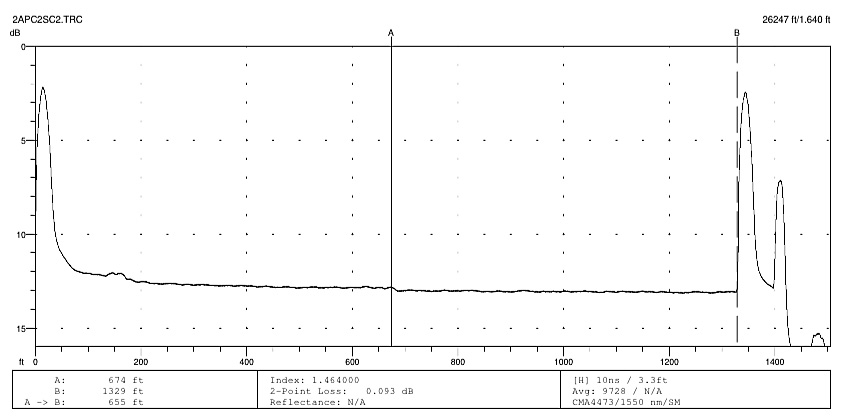
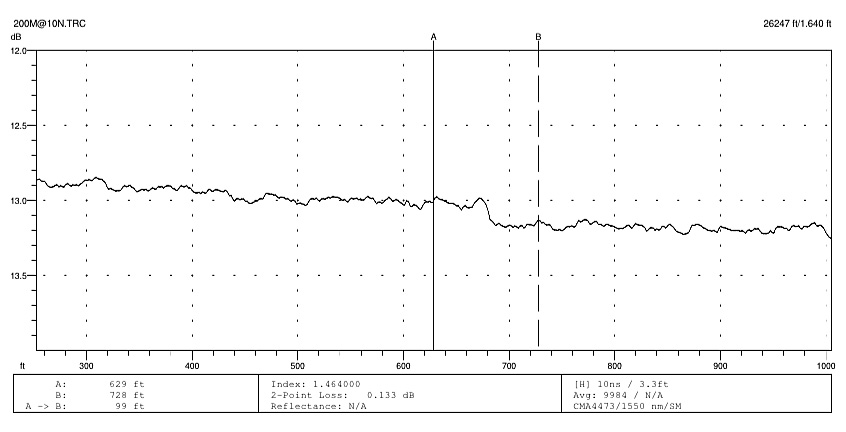
September 2022
Splicing Pigtails On A Cable
Q: I seem to be having an issue finding fiber protection sleeves
that can slide over the 3mm patch cable. I bought a sleeve that said it
with made for “single fiber fusion” but the thru hole which I would
side the cable thru prior to fusion is too small for the patch cable.
When I try and look on-line for specifications for the thru-hole size,
prior to fusion final melting of the glue in the sleeve, all I find are
post-melting diameters, none which are even close to being able to
handle the 3mm patch cable.
A: Splicing pigtails involves splicing the fibers only and the
cables are secured separately. The usual method of splicing on pigtails
is to splice the fibers and use the heat shrink tube to seal the splice
and the fibers from the outside air and protect it from stress. The
splice is placed in a splice tray. On either side, there is 2-3 feet of
fiber exposed from the cables being spliced. The splice tray has clamps
for all of the cables being spliced on the edges of the tray and the
fiber to the splice is coiled neatly on the splice tray. The jacket of
the pigtail is clamped at the edge of the splice tray but ends there,
so only fiber is coiled in the tray. If you try to coil fiber, the bulk
of the cable can get to be a problem where it’s coiled with the bare
fiber. You can get heat shrink protectors for fibers of 250 to 900 micron diameter buffers, but not for jacketed cables.
Important Questions From The Past
Managing And Maintaining a Fiber Optic Cable Plant During Its Lifetime.
Q: Are there guides / recommendations for optic fibre cable life cycle management? (outside plant) including rehabilitation / replacement timelines together with factors that may alter those timelines ( such as seismic activity, extreme weather, human activity-induced fibre cuts etc) also including typical performance deterioration over the life cycle, and the performance levels at which replacement / rehabilitation happens. Or does it happen (and is it normally expected) that operators replace entire sections of fibre (say 400 km) as part of routine maintenance?
A: There is a saying here in the US that in fiber optics “the most common cause of failure is “backhoe fade” in underground cables and “target practice” for aerial cables.” In other words, damage caused by humans. We know of many fiber optic cable plants that have survived natural disasters like earthquakes - in fact there is a lot of work today using regular cables used in communications to monitor for seismic activity. Fire can be a problem in remote areas, but often it’s because the poles are burned causing the cables to fall.
Over the years we have questioned cable manufacturers about the lifetime of fiber optic cable. They don’t like to make definitive statements but we have been told that based on the cables installed in the past that 40 years is a probable lifetime for most cables. There are certainly cables in use today that are over 30 years old already. The glass fiber is not a problem, it’s the protection from the cables that will eventually fail. Installation techniques can have an effect on the longevity. For example splice closures should be sealed properly to prevent ingress of moisture or dirt. Cables should not be installed with bends below the rated bend radius or with excess tension.
FOA has always told users that fiber optic cables do not need maintenance (https://foa.org/tech/ref/user/maintain.html), a response to some people advocating periodic inspection and cleaning of connections, for example. That’s just more likely to cause damage.
When an accidental break in a cable occurs, we have guidelines for restoration (https://foa.org/tech/ref/restoration/rest.html), and planning for restoration when building the cable plant is very important.
Someday you will certainly want to replace cables, often well before the lifetime of the cable, but generally because you need more fiber or the older fiber will not support the network speeds you want for upgrades. Planning for more fiber by installing more cables can be eased by installing spare underground ducts when first installing cables - here in the US, we call this “Dig Once” (https://foa.org/tech/ref/OSP_Construction/Underground_Construction.html). Testing fibers for higher speeds is called "fiber Characterization” (https://foa.org/tech/ref/testing/test/CD_PMD.html) and is routinely done when speeds above 10G or certainly 100G are considered for older fibers.
Knowing that the lifetime of fiber optic cable plants are ~40 years, it makes sense to plan ahead for future applications, installing lots of fibers, leaving lots of open duct space and choosing network architectures that will not obstruct upgrades. See the article on Netly's network above.
Fiber Optic Color Codes Reference Chart
Q: Has anyone made a fiber optic pocket reference chart that has cable color orders, frequencies, or other commonly used info on it?
A: The FOA has a page on its Online Guide that covers color codes (https://foa.org/tech/ColCodes.htm). It is the most popular page in the FOA Guide! It works great with a smartphone.
More Q&A in the FOA FAQs Page

The word on the "Dig Once" program is getting out - FOA is getting calls from cities asking us for information and advice. Here are some links:
The DoT page on the administration’s Executive Order: http://www.fhwa.dot.gov/policy/otps/exeorder.cfm
And the one to download and hand out:
A “How To” Guide from The Global Connect Initiative: https://share.america.gov/wp-content/uploads/2016/04/6.-GCI-Dig-Once.pdf
Is There A Standard For Fiber Optic Installation?
Another question we get often is "Is there a standard for fiber optic installation." The answer is yes, but not from the usual standards groups you might expect. Over 20 years ago, the National Electrical Contractors Association (NECA) asked FOA to help create a standard for installation. That standard, ANSI/NECA/FOA-301 has been updated three times already and is about ready for another update.
Unlike most of those groups who charge you a fortune for standards, FOA covers the cost so ANSI/NECA/FOA-301 is available free from FOA.

Download your free copy of ANSI/NECA/FOA-301 here (PDF)
Older questions are now available here.
Training / FiberU
News and resources to help you learn more and stay updated.
Find a listing of all the FOA-Approved schools here.

Free online self-study programs on many fiber optics and cabling topics are available at Fiber U, FOA's online web-based training website.
Free online training at Fiber U
The FOA has >100 videos on

FOA School News
FOA's roster of approved schools is growing as more organizations
recognize our expertise in workforce development and our comprehensive
support for getting new schools started. FOA has over 25 years
experience and nearly 90,000 certified fiber techs (with ~120,000
certifications). As a non-profit organization founded by the industry
specifically to develop a competent workforce, FOA provides the
consultation, curriculum and contacts to get schools started as a free
service to new schools.
Complete listing of FOA Approved Training Organizations
Need A Fiber Optic Course Onsite? Invite an FOA School To Come To You
FOA often gets inquiries from an organization that
has personnel that needs training in fiber optics. Recent inquiries have
included contractors, a manufacturer of high-reliability products using
fiber optics and a cable manufacturer. In many cases, where there are
several people needing training, FOA can recommend a FOA Approved School
and Certified Instructor who will come to their location to teach a
class. The advantage is of course the savings in travel costs if
the class comes to you, but it also offers the opportunity to customize
the course to fit your needs, even use your equipment or work on your
components, so the training is more relevant to those taking the class.Contact FOA to discuss the idea of a custom, on-site class to see if it will better meet your needs.
Fiber U On-The-Job Training (OJT) Program
The FOA Fiber U OJT program for novices combines online study at Fiber U with OJT with mentoring by experienced co-workers and their supervisor to help new employees develop into FOA-certified technicians in only one year.
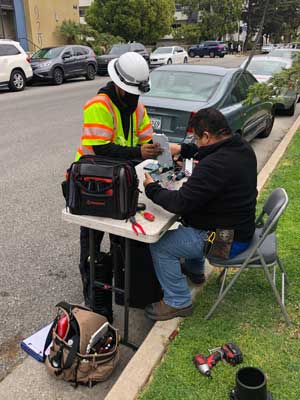
The FOA Fiber U “OJT-To-Cert” program includes both fiber optics and premises cabling (copper, fiber & wireless), so it covers techs working in both outside plant and premises jobs.
Like other FOA programs, the OJT-To-Cert program is free. If you and/or your company is interested in the FOA OJT-To-Cert program, contact FOA.
To explain how OJT
works and FOA's OJT-To-Cert program, FOA created a
short video: Lecture 62: On
The Job Training For Fiber Optics Using Fiber
U
FOA
Direct Certification Program For Experienced Fiber Optic Techs
Experience Plus Online Study At Fiber U = FOA Certification
Experienced fiber optic technicians can become FOA Certified using their experience in fiber optics and study for the FOA certification exams online at Fiber U. Thousands of industry professionals have applied to the FOA directly for certification without the need for classroom training, based on their knowledge and skills developed working the field. Since FOA certifications are based on KSAs (knowledge, skills and abilities), current techs can show the skills and abilities required through their field experience. FOA provides free online self-study courses at Fiber U for the knowledge part to prepare you for FOA certification exams which you can also take online.
If you are an experienced field tech interested in certification, and FOA is the internationally recognized certifying body for fiber optics, you can find out more about the FOA Direct Certification Program here.
If you are already a CFOT, FOA also offers many specialist certifications you can obtain based on your experience as a field tech. See what's available at Fiber U.
Fiber U "Basic Fiber Optics" Online Self-Study Course Now In Spanish
El curso de autoaprendizaje en línea "Fibra óptica básica" de Fiber U ahora en español
El sitio de aprendizaje en línea de FOA, Fiber U, tiene más de dos docenas de cursos de autoaprendizaje gratuitos sobre fibra óptica y cableado de instalaciones. Como era de esperar, el tema más popular es el curso "Fibra óptica básica", que se utiliza para iniciarse en la fibra óptica y como curso de preparación para realizar el examen de certificación FOA CFOT.
Ahora el curso básico de fibra óptica está disponible en español, utilizando el libro de texto FOA en español, la sección de la Guía en línea en español y la capacidad de YouTube para traducir subtítulos de video al español. El curso funciona exactamente como la versión en inglés con 10 lecciones, cada una con cuestionarios y una opción para tomar un examen de Certificado de finalización.
Para presentar el nuevo curso de
español Fiber U, el examen Certificate of
Completion es gratuito, así que dígaselo a sus
contactos.
Curso Básico de Fibra Óptica
de Fibra U en español.
New Fiber U Course: Fiber Characterization
FOA has added a new course at Fiber U on Fiber Characterization. Fiber
characterization is the process for testing long fiber cable plants for
its ability for carrying high speed communications. With so many
networks now operating at 100, 200, 400 or even 800 Gb/s, fiber
characterization is important, especially on older fiber optic cable
plants.The free Fiber U Fiber Characterization course is available in two forms, as a standalone Fiber U fiber Characterization Course with its own Fiber U Certificate of Completion and as a separate Lesson in the Fiber U Fiber Optic Testing course. This course is recommended for those studying for the FOA CFOS/FC Fiber Characterization certification.
Fiber U MiniCourses: Got An Hour Or Less? Learn Something New About Fiber Optics.
FOA has introduced a new type of Fiber U course, the MiniCourse, a free online course you could take in a short time, perhaps as you ate lunch at your desk or took a coffee break. The topics of these courses should explain what they are about, and these are all very important topics to fiber optic techs.
New Fiber U MiniCourse - Fiber Optic Jargon
There is a new MiniCourse at Fiber U - Fiber Optic Jargon. Jargon is the most important thing you need to learn when you learn about a new technology. This short Fiber U MiniCourse is intended to introduce you to fiber optic jargon and make learning about fiber much easier. It's aimed at novices but is a good refresher for even experienced techs.
Fiber Optics In Communications
How Optical Fiber Works
Fiber Optic Network Restoration
Fiber Optic Connector Identification
Fiber U Color Codes
The Mysterious dB of Fiber Optics
Fiber Optic Cable Bend Radius
Fiber Optic Link Loss And Power Budgets
Fiber Optic Connector Inspection And Cleaning
Fiber Optic Media Conversion
Fiber Optic Cable Midspan Access
Reading An OTDR Trace
Reference Cables For Testing
Fiber Optic Attenuators
The courses have two components, video lectures and readings, that are complementary. As usual there is a self-test to allow you to check your comprehension. As with other Fiber U courses if you desire, you can take a short test for a Fiber U Certificate of Completion that costs only $10.
All these free courses and many more are available at Fiber U.
What Fiber Techs
Don't Know -
What We Learn From FOA Certification Tests
As FOA moves more testing over to our digital online testing system at ClassMarker, we have access to more data about our testing, including what questions and topics on the tests are answered incorrectly most often. Having this data gives us an opportunity to evaluate the questions and how they are stated, but more importantly it allow us to help our instructors teach the subjects and us to change our curriculum and online courses to emphasize these particular topics. These are some of the topics that we have noticed are answered incorrectly more often in FOA and Fiber U tests.
Most of the questions missed are on testing.
1. OTDRs - particularly what information is in the OTDR trace.
2. The difference between dB and dBm
3. Loss budgets - both the concepts and doing the math
4. Insertion loss testing - single-ended or double ended for testing patchcords or cable plants, how to set 0dB references
5. Units of measure - fiber is measured in microns, wavelengths in nanometers, etc.
At FOA, we're working to add Fiber U MiniCourses on these topics and working with our schools to emphasize these topics in their classes.
If you are going to be taking a FOA certification course or test in the near future, these topics should be on your final exam study list.
What We Learn From Hands On Labs
We learn about students performance in hands-on labs from the feedback of our instructors and our own experiences too. One big problem is the use of hand tools. Growing up today, you learn how to use keyboards, mouses and touch screens, but decades ago, you also learned how to use basic hand tools. This is big enough of a problem that we're considering adding some video lessons on basic hand tools to prepare students for cable prep, termination and splicing that require the use of hand tools.
FOA Guide "Basics Of
Fiber Optics" Now Available Online in Portuguese
(6/2020)
FOA
has now translated the Basics of Fiber Optics
textbook in our Online Guide into Portuguese,
joining Spanish and French translations. For those
speaking Portuguese, we have the technical
information and for schools we also have curriculum
available. Here is the FOA Guide in Portuguese, Spanish and French translations.
Time
To Learn - Online
Some
schools have been closed during the pandemic, so FOA
has been working with them to create new online
learning experiences that can in some cases lead to
certification online. FOA certifications are still
based on the KSAs - knowledge from the classroom,
skills from the labs and abilities judged by
instructors or proven by actual experience. ZOOMing
Much of what we're doing benefits from the capabilities of "Zoom." Others have created videoconferencing apps, but none work so well, especially with limited bandwidth. We've seen remote labs that have an instructor showing students how to use the tools they were sent then watching them duplicate their actions. We have worked out methods to use Zoom to proctor FOA's online certification exams.
Blended Learning
While most FOA schools have suspended in-person training during this period, some are offering a "blended learning" option. That means that students sign up for a FOA certification course, take the classroom sessions on Fiber U with the assistance of a FOA certified instructor. Now online instruction can include reviewing the labs using the Fiber U Basic Skills Labs, then when it's possible to attend classes at the school, complete the hands-on labs and take the FOA certification exam.
Online Remote Labs
Alternatively, some schools are experimenting with "remote labs," where the students get sent tool kits and components and labs are conducted by videoconferencing. Before the labs, the students may watch demos by their instructor on videoconferencing and/or review the relevant "virtual hands-on" lessons in the Fiber U Fiber Optics Basic Skills Labs so they will already know the steps in the exercises. And Fiber U has the new Fiber U DIY Basic Skills Lab lesson with directions on how to purchase inexpensive tools online and use them to learn basic fiber optic skills. Videoconferencing allows the instructor to remotely monitor their work and provide help as needed. Contact the FOA for more information.
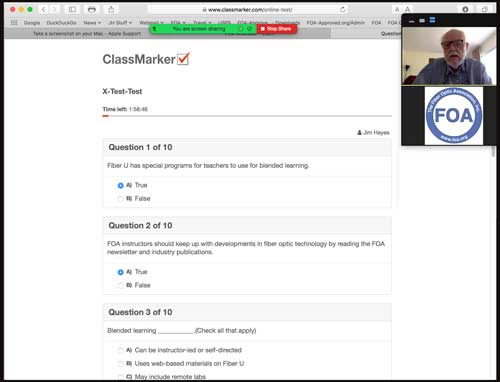
FOA Zoom Exam Proctoring
Online Certification Testing
FOA has all its certification tests available online, both for use by our schools and by our direct "Work to Cert" applicants. All FOA certification tests require a proctor to oversee the applicant taking the exam. In this time of social distancing, getting a proctor can be difficult, so FOA now has procedures for online proctors administering the exam. Contact the FOA for more information.
OJT - On-The-Job-Training
Many novices get a job and learn on the job. They usually have an experienced tech who helps them gain the knowledge and learn the skills they need to perform their job. Thinking about this in relation to the FOA KSAs, the knowledge, skills and abilities needed by a fiber optic tech, the tech will learn skills but not the basic knowledge that helps them understand the processes involved. FOA can offer help here with our FOA's OJT-to-Cert Program, using our Fiber U online self-study programs. While the tech learns on the job, they become a Fiber U trainee, getting the knowledge they need, while working under their "mentor" at work. This is particularly good for contracting companies who need techs but do not have the usual training courses available. Interested in OJT programs? Click on the link below or contact FOA for more information.
FOA's OJT-to-Cert Program

FOA offers free online self-study programs at Fiber U. Many users are preparing for FOA certification programs - taking courses at our schools or using the "Work-to-Cert" program. Some of our schools are requiring Fiber U programs as prerequisites for their classroom courses so they can spend more time on hands-on activities.
FOA School Offers Toolkit With Online Training
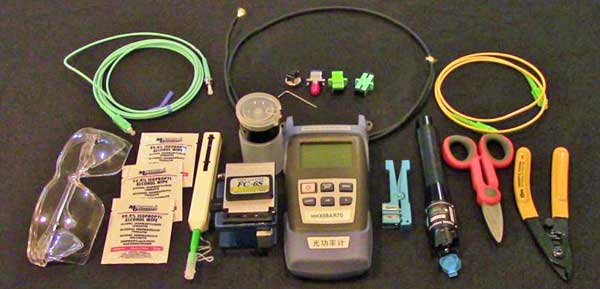
Slayton Solutions (FOA Approved School #156) is offering a simple fiber optic tool kit that includes a 29-piece set of fiber optic tools and a power meter along with training videos and online instruction for only $499. 29 Piece Kit includes all tools and devices a technician needs to install fiber optic connectors and test optical power. You can contact them for more information at slaytonsolutions@sbcglobal.net or https://www.fiberopticsinstitute.com
Publications / Resources
Cross Reference To FOA Tech Materials
FOA has so much technical reference material, we created a cross reference guide to the textbooks,
Online Guide and Fiber U courses, all the FOA technical information.
Besides the textbooks, online Guide and Fiber U, each section of the
Guide also includes links to the 100+ FOA videos available.
Cross Reference Guide to Textbooks, Online Guide and Fiber U
FOA Guide To Fiber Optic Workforce Development
To help those new to fiber optic workforce development, FOA has created a web page we call "Fiber Optic Workforce Development."
In this page, we share what we have learned about the fiber optic
workforce, who they are and how they learn their trade. We discuss what
defines a fiber optic tech and how they should be certified.
Read the FOA Guide To Fiber Optic Workforce Development online.
Latest FOA Book: Fiber Broadband (Paperback and Kindle)
 In less than half a century,
fiber optics has revolutionized communications and to a large extent,
society in general. Broadband, what many today call high speed Internet
access, has become a necessity for everyone, not a luxury. The
technology that makes broadband possible is fiber optics, connecting the
continents, cities, and just about everybody. Even fiber to the home
(FTTH) brings broadband to hundreds of millions worldwide.
In less than half a century,
fiber optics has revolutionized communications and to a large extent,
society in general. Broadband, what many today call high speed Internet
access, has become a necessity for everyone, not a luxury. The
technology that makes broadband possible is fiber optics, connecting the
continents, cities, and just about everybody. Even fiber to the home
(FTTH) brings broadband to hundreds of millions worldwide. How did we get from an era when communications was making a telephone call or sending a telegram to today’s world where every piece of information – and misinformation – is available at the click of a mouse or touch on a screen? How did we get from a time when a phone was connected on copper wires to being able to connect practically anywhere on a handheld device with more computing power than was available to scientists and engineers only decades ago?
How does broadband work? Without fiber optics it would not work.
This book is not the typical FOA technical textbook - it is written for anyone who wants to understand fiber broadband or fiber optics or the Internet. It's also aimed at STEM teachers who want to include communications technology in their classes. This book will try to explain not only how fiber broadband works, but how it was developed. It is intended to be an introduction to communications technology appropriate for a communications course at almost any level (junior high, high school or college,) for managers involved with broadband projects, or for anyone who just wonders how all this stuff works.
The Fiber Optic Association Guide To Fiber Broadband
Paperback ($12.95) and Kindle ($9.95) versions available from Amazon or most booksellers. Kindle version is in color!
More Translations of FOA Textbooks
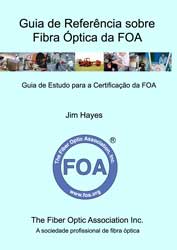 FOA is a very international organization and it works hard to
accommodate the language needs of everyone. We have been translating our
books and website into the languages most requested, and this month, we
add two more textbook translations. We also want to thank Jerry Morla,
FOA CFOS/I instructor and Director who has been doing the recent
translations into Spanish, his native language.
FOA is a very international organization and it works hard to
accommodate the language needs of everyone. We have been translating our
books and website into the languages most requested, and this month, we
add two more textbook translations. We also want to thank Jerry Morla,
FOA CFOS/I instructor and Director who has been doing the recent
translations into Spanish, his native language.
Here is a listing of all the FOA textbook Translations
Spanish Editions:
Guía de Referencia de la Asociación de Fibra Óptica (FOA) Sobre Fibra Óptica: Guía de estudio para la certificación de la FOA Amazon
La Referencia de Cableado para Predios de la FOA: Guía para Certificación de la FOA Amazon
La Asociación de Fibra Óptica Manual de Fibra Hasta el Hogar : Para Planificadores, Gestores, Diseñadores, Instaladores y Operadores De FTTH Amazon
Guía de Referencia de la FOA sobre Diseño de la red de fibra óptica: Guía de Estudio para la Certificación de la FOA Amazon
And the FOA Reference Guide To Fiber Optics:
French Edition: Le Guide de référence de la FOA pour la fibre optique et et guide d'étude pour la certification FOA: Guide d'étude pour la certification FOA Amazon
Portuguese Edition: Guia de Referência sobre Fibra Óptica da FOA : Guia de Estudo para a Certificação da FOA Amazon
The subject matter of these books is also translated in the FOA Guide online.
Planning A Fiber Optic Project?
The FOA Guide To Fiber Optic Projects includes this timeline and comments on project planning and implementation.More New FOA Video
Lectures On YouTube
Did you know YouTube
will close caption videos in many languages?
Here are directions.
FOA YouTube Video Describes On-The-Job Training (OJT)
FOA Lecture 67 Fiber Optics At Electrical Utilities
Like all our YouTube lectures, they are all short and easy to understand.
Did you know YouTube will close caption videos in many languages?
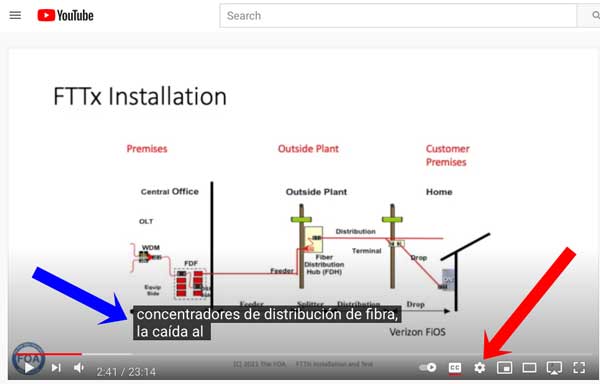
Sign in with Google to get translations for closed captioning. Click on the settings icon (red arrow.) Choose "Subtitles". English is the default language. Click on the arrow after "English (auto-generated) >". In the new window click on "Auto-translate" and choose the language you want.
FOA Loss Budget
Calculator On A Web Page 5/2020
FOA has written many articles about loss budgets, something everyone involved in fiber optics needs to know and needs to know how to calculate. We recently discovered how to get a spreadsheet ported to a Web page, so we created this web page that calculates loss budgets. We have an iOS loss budget app, but with this web page, you can calculate loss budgets from any device, smart phone, tablet, laptop, or desktop computer that has web browsing capability.

Bookmark this page (especially on your smartphone): FOA Loss Budget Calculator Online
 We are continually updating the Online Reference
Guide to keep up with changes in the industry and
adding lots of new pages of technical information.
When you go to the FOA
Guide Table of Contents to see the latest
updates - look for
We are continually updating the Online Reference
Guide to keep up with changes in the industry and
adding lots of new pages of technical information.
When you go to the FOA
Guide Table of Contents to see the latest
updates - look for  .
.Recent updates:
FTTH Updates: Added a section on FTTH Network Design, updated Architecture and PONs (10G)
Color Codes For Fiber Optics Includes print your own pocket guide and versions for your smartphone.
Fiber Optic Projects - the FOA Guide to projects from concept to operation
Coherent Communications Systems in the FOA Guide.
Go to The FOA Online Fiber Optic Reference Guide.
FOA Reference Books
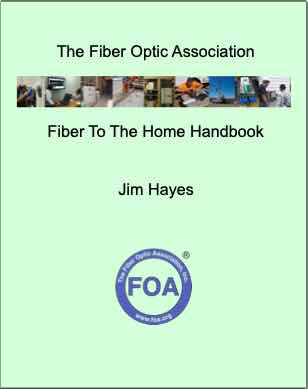
FOA's FTTH Handbook: We've gathered all our information on FTTH from the FOA Guide and past issues of the FOA Newsletter and edited it into a 112 page "FTTH Handbook." We even added a section on planning and managing FTTH Projects.
The Fiber Optic Association Fiber To The Home Handbook is available from Amazon in print and Kindle editions.
Sitio web y manual de FTTH ahora en español
Sitio web y manual de FTTH ahora en español - FTTH Website And Handbook Now In Spanish
El Manual FOA FTTH se ha convertido en el libro FOA más vendido y tiene una calificación de 4.7/5 por parte de los compradores en Amazon.FOA ha notado mucho interés en FTTH en otras áreas del mundo, especialmente en América Central y del Sur, por lo que tradujimos el sitio web de FTTH y el Manual de FTTH al español.
Available in paperback from Amazon or ebook on Amazon Kindle.
Disponible como libro de tapa blanda en Amazon o como libro electrónico en Amazon Kindle.
El sitio web de FOA FTTH ahora en español.
El Manual FOA FTTH se ha convertido en el libro FOA más vendido y tiene una calificación de 4.7/5 por parte de los compradores en Amazon.
FOA ha notado mucho interés en FTTH en otras áreas del mundo, especialmente en América Central y del Sur, por lo que tradujimos el sitio web de FTTH y el Manual de FTTH al español.
Disponible como libro de tapa blanda en Amazon o como libro electrónico en Amazon Kindle.
El sitio web de FOA FTTH ahora en español.


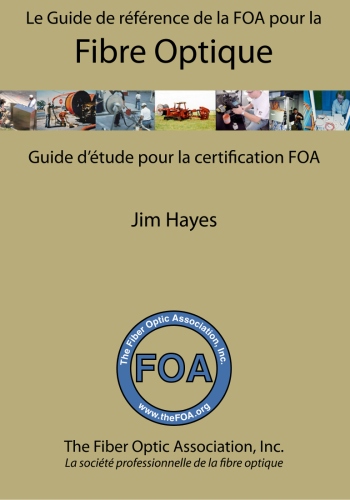





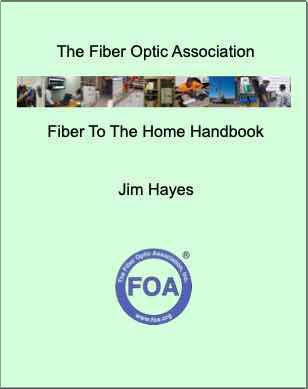
Fiber Optics (4 languages), Premises Cabling, OSP fiber and construction, Network Design, Testing and FTTH
-
The FOA has it's own
reference books for everyone working in fiber
optics - contractors, installers and end users as
well as for use as textbooks in classes at
educational institutions. They are available as
printed books or Kindle at much lower prices than
most textbooks since we self-publish and sell
online, cutting out the middlemen. Click on the
book images for more information. The Reference
Guide To Fiber Optics is also available in
Spanish, French and Portuguese. The Design book is available in English
and Spanish.
Click on any book for more information about it.
FOA has reprinted

"Lennie Lightwave's Guide" on its 25th anniversary in a special print edition.
Lennie and Uncle Ted's Guides are online or as free iBooks on iTunes.


Click on any of the books to learn more.
- Fiber Optic Safety Poster to download and print
Resources For Teachers In K-12 And Technical Schools
Teachers in all grades can introduce their students to fiber optic technology with some simple demonstrations. FOA has created a page for STEM or STEAM (science, technology, engineering, arts and math) teachers with materials appropriate to their classes. Fiber Optic Resources For Teachers.
Safety
On Safety
The FOA is concerned about safety!FOA considers safety an integral part of all our programs, curriculum materials and technical materials. We start all our textbooks and their online versions with a section on safety in the first chapter, like this: Before we get started - Safety First!
There are pages on the FOA Guide on Safety procedures Including Eye Safety and. Digging Safely
And a YouTube lecture: FOA Lecture 2: Safety When Working With Fiber Optics
In our OSP Construction Section, these pages cover many safety issues including those related to the construction of the cable plant: Project Preparation And Guidelines, Underground Cable Construction, Underground Cable Installation and Aerial Cable Installation.
There is even a safety poster for the fiber activities: PDF Safety Rules For Fiber Optics
Other Safety Resources:
There is a toll-free
"call before you dig" number in the USA: Dial 811. See www.call811.com
for more information in the US. Here is their map of resources by states.
In Canada, it's "Click Before You Dig.com" They also have a page of resources by US states and Canadian provinces.
The Common Ground
Alliance has an excellent "Best Practices Guide"
online
- The US Department of Transportation has a website called "National Pipeline Mapping System" that allows one to search for buried pipelines.
Why We Warn You To Be Careful About Fiber Shards

Photo courtesy Brian Brandstetter, Mississauga Training Consultantcy
2023 Conference On Damage Prevention In Tampa

Global Excavation Safety Conference
February 14-16, 2023
GlobalExcavationSafetyConference.com:

The magazine, dp-Pro, sponsor of the conference, has also published it's latest issue with an article by FOA on "New Construction Techniques in Fiber Optics" and a overview of the FOA. You can read the magazine here.
When You Bury Marker
Tape, Bury One That Will Work (July 2021)
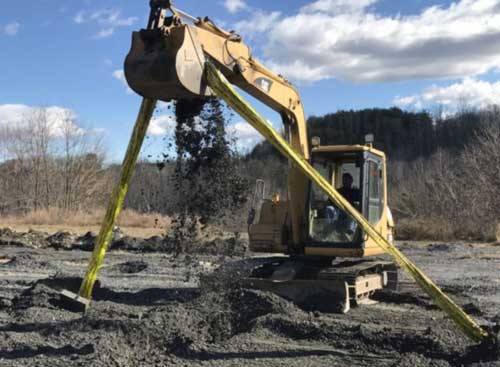
Signaltape® provides a visual warning by ensuring tape is brought to the surface, alerting the operator to the presence of a buried utility. It includes a 3,000-lb. tensile strength aramid fiber membrane, which ensures the tape is pulled to the surface to alert the excavation crew. Signaltape comes in two sizes: 12″ x 1000′ or 6″ x 1000′.
FOA Corporate Program - Products & Services
Search for products and services offered by hundreds of fiber optic companies worldwide.
List of corporate information on the FOA website.
FOA Corporate Program is available to companies involved in fiber optics as manufacturers, contractors, installers, etc. Read more.
FOA/About
About The FOA
- Contact
Us: http://www.foa.org
or email <info@foa.org>
FOA has a company page and four LinkedIn Groups
FOA - official company page on LinkedIn
FOA - covers FOA, technology and jobs in the fiber optic marketplace
FOA Fiber Optic Training - open to all, covers fiber optic technology and training topics
Grupo de La Asociación de Fibra Óptica FOA (Español)
What is The FOA?
The FOA is a, international non-profit educational association chartered to promote professionalism in fiber optics through education, certification and standards.
Founded in 1995 by a dozen prominent fiber optics trainers and leaders from education, industry and government as a professional society for fiber optics and a source of independent certification, the FOA has grown to now being involved in numerous activities to educate the world about fiber optics and certify the workers who design, build and operate the world's fiber optic networks.
Read More
FOA History
FOA Timeline of Fiber Optics
Contact Us
The Fiber Optic Association Inc.
https://www.foa.org or email <info@foa.org>
https://www.thefoa.org or email <info@thefoa.org>
Telephone/text: 760-451-3655
The FOA Home Page

Want to know more about fiber optics? Study for FOA certifications? Free Self-Study Programs are on "Fiber U®." Looking for specific information? Here's the largest technical reference on the web: The FOA Online Fiber Optic Reference Guide.

Free online self-study programs on many fiber optics and cabling topics are available at Fiber U, FOA's online web-based training website.
-
Contact Us
The Fiber Optic Association Inc.
Fiber Optic Timeline
(C)1999-2023, The Fiber Optic Association, Inc.
FOA Logo Merchandise
-
New FOA Swag! Shirts,
Caps, Stickers, Cups, etc.
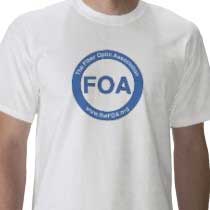

Your Name, CFOT® - It pays to advertise!
The FOA encourages CFOTs to use the logo on their business cards, letterhead, truck or van, etc. and provides logo files for that purpose. But we are also asked about how to use the CFOT or CFOS certifications. Easy, you can refer to yourself as "Your Name, CFOT" or "Your Name, CFOS/T" for example.
Feel free to use the logo and designations to promote your achievements and professionalism!
Contact FOA at info@thefoa.org to get logos in file format for your use.Privacy Policy (for
the EU GDPR): The FOA does not
use cookies or any other web tricks to gather
information on visitors to our website, nor do
we allow commercial advertising. Our website
hosts may gather traffic statistics for the
visitors to our website and our online testing
service, ClassMarker, maintains statistics of
test results. We do not release or misuse any
information on any of our members except we will
confirm FOA certifications and Fiber U
certificates of completion when requested by
appropriate persons such as employers or
personnel services.
Read
the complete FOA Privacy Policy here.




